Now I'll write the article following the specific format and word count requirements.Wood deck railings serve as both essential safety features and distinctive design elements that can transform your outdoor living space. These versatile structures not only provide security and support but also define the character and style of your deck. From classic picket designs to innovative mixed-material approaches, wood deck railings offer endless possibilities for customization. The natural warmth and beauty of wood materials like cedar, redwood, and pressure-treated lumber create inviting outdoor environments that complement various architectural styles while enhancing your home's overall aesthetic appeal.
1. Classic Wood Deck Railing Picket Design
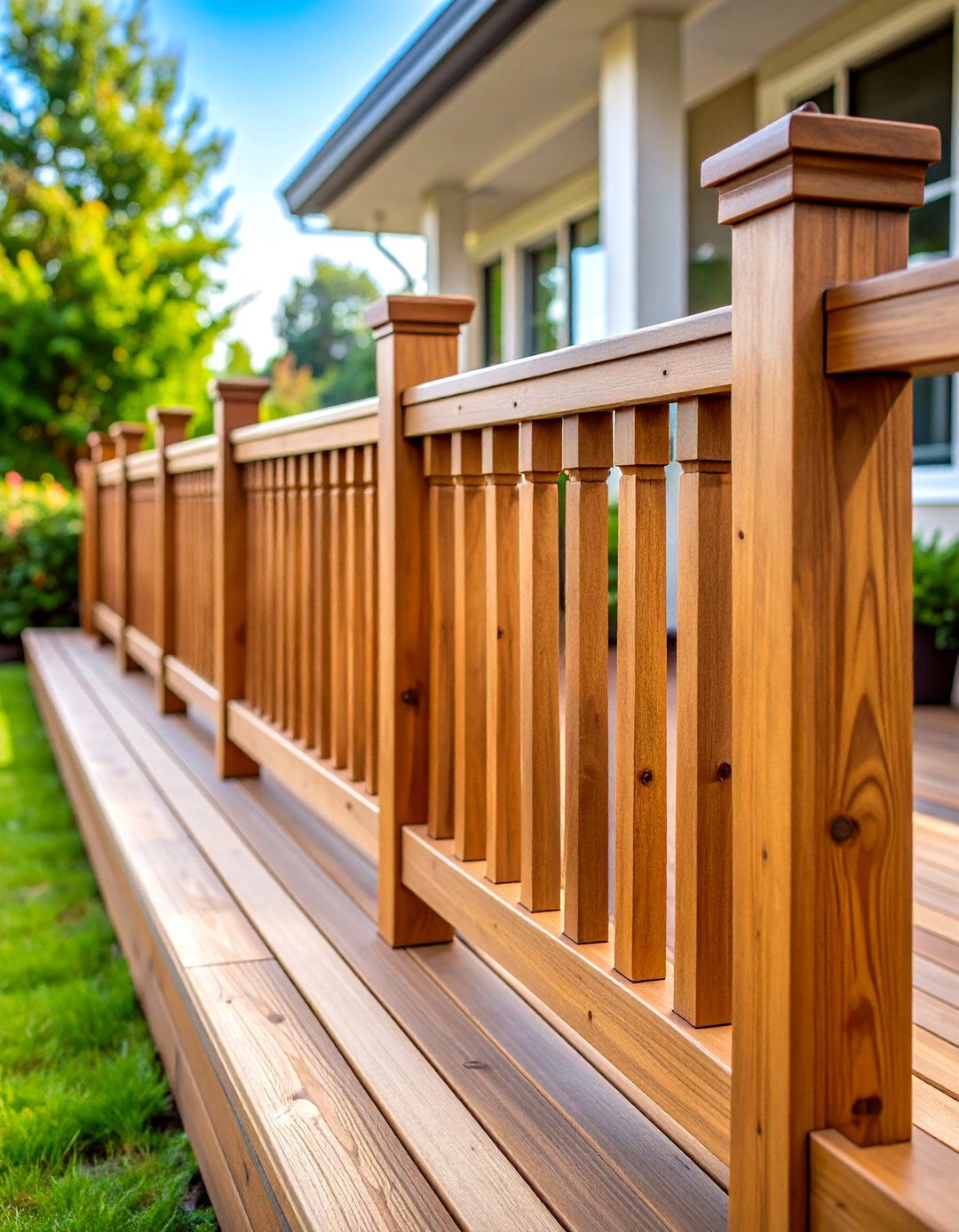
The timeless wood deck railing picket design remains the most popular choice for homeowners seeking traditional elegance. This vertical baluster system features evenly spaced wooden pickets held together by horizontal top and bottom rails, creating clean lines that complement virtually any architectural style. With this design, you have evenly spaced, vertical wooden pickets that are held together by horizontal top rails and bottom rails. This simple vertical baluster design has a lot of versatility and can complement many home and landscape designs. The spacing between pickets must comply with building codes, typically maintaining gaps no wider than four inches for safety. This wood deck railing style works exceptionally well with both contemporary and traditional homes, offering excellent durability when constructed from quality lumber like cedar or pressure-treated pine.
2. Horizontal Wood Deck Railing Slats
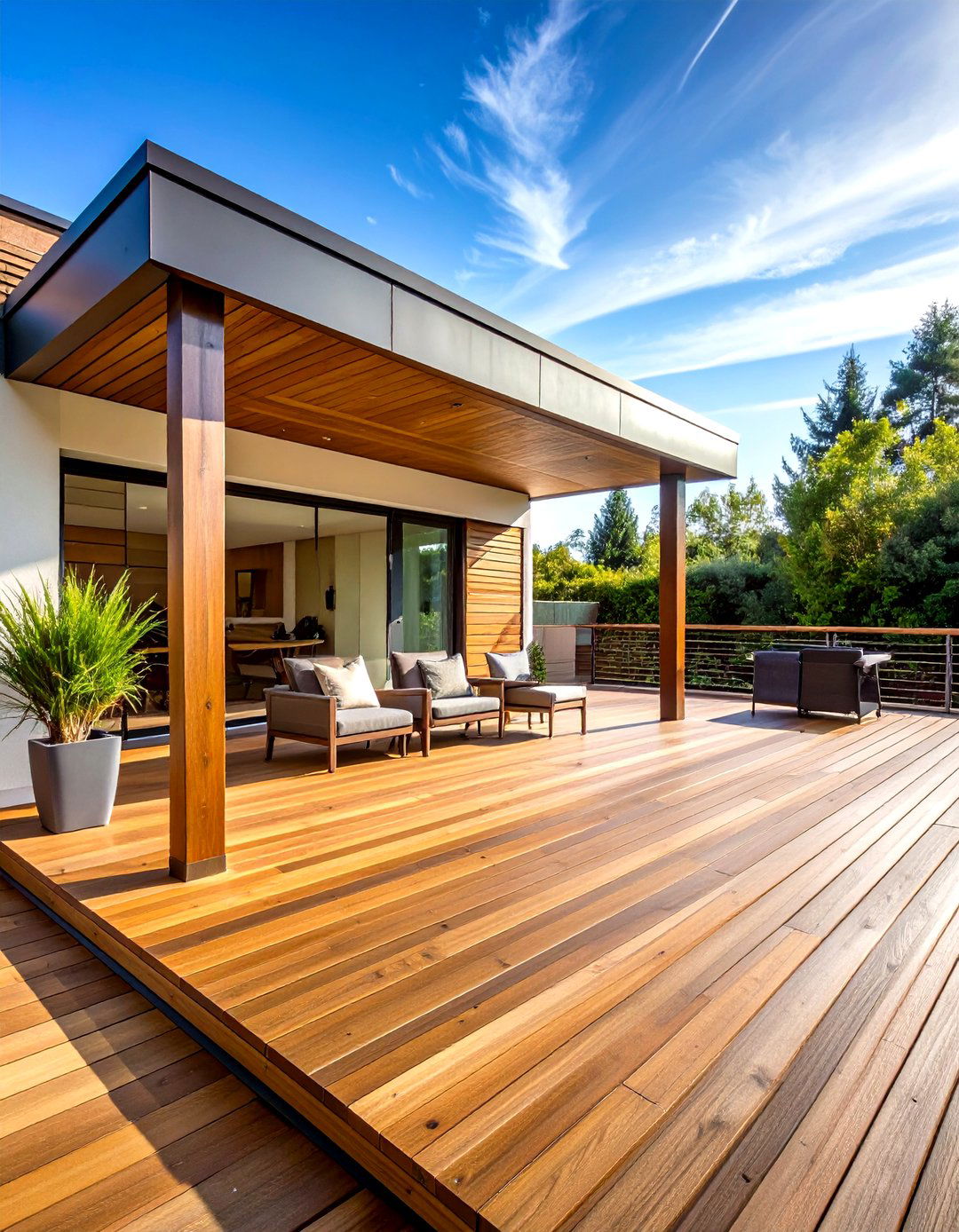
Horizontal wood deck railing slats offer a modern twist on traditional vertical designs while providing enhanced privacy for your outdoor space. Thin wooden boards mounted horizontally between posts offer a natural touch to your deck's border. The slats, usually 2-4 inches wide, can be spaced closer or further apart to control privacy levels. This contemporary wood deck railing style creates visual interest through its linear pattern and can make smaller decks appear larger. The horizontal orientation works particularly well with modern and minimalist home designs, while the natural wood material maintains warmth and connection to outdoor environments. Installation requires careful attention to proper spacing and alignment to achieve the clean, streamlined appearance that makes this wood deck railing design so appealing.
3. Wood Deck Railing with Cedar Material
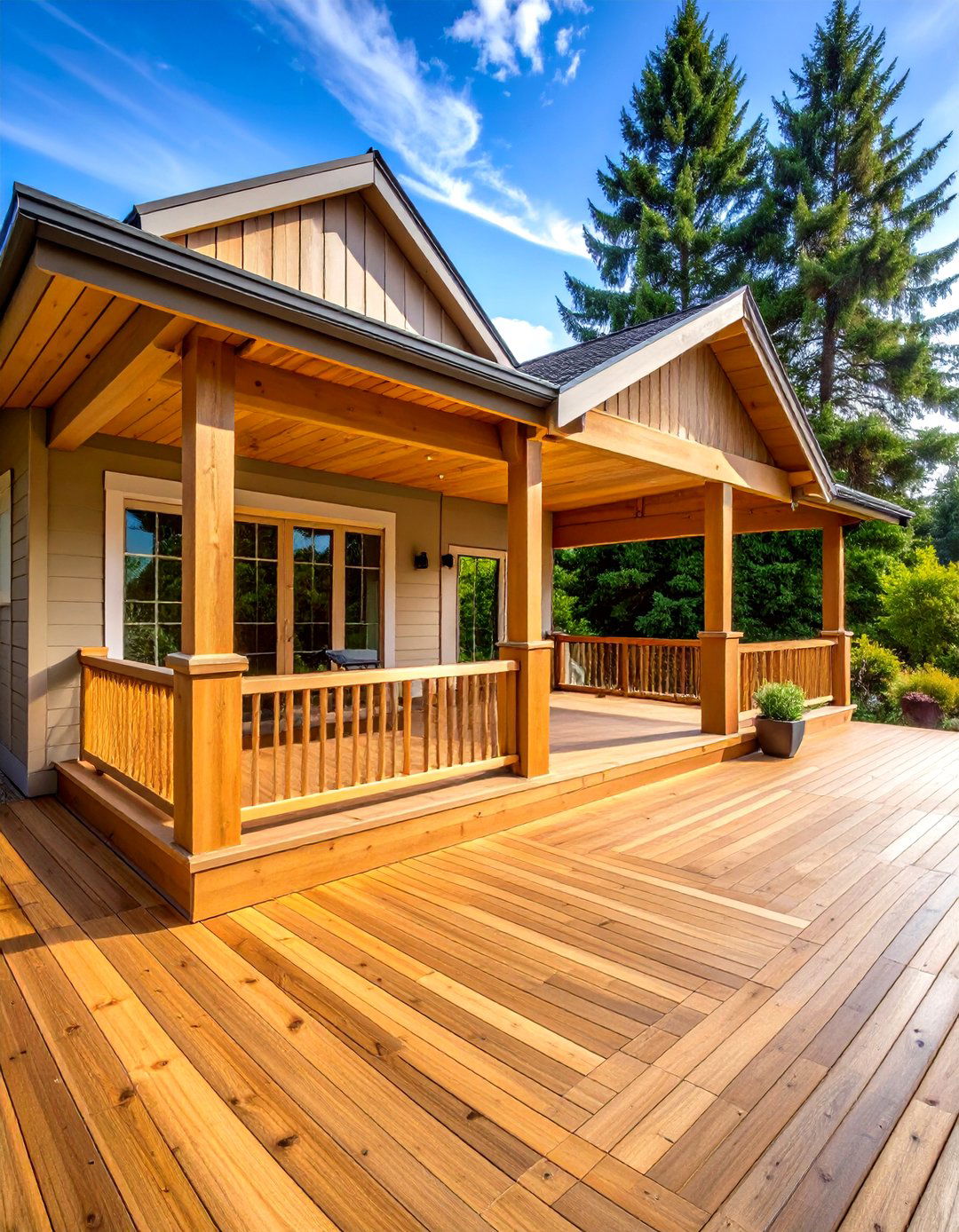
Cedar wood deck railing construction combines natural beauty with exceptional durability, making it an ideal choice for outdoor applications. Cedar and redwood do not require the harsh chemicals that pressure-treated lumber does, and have a natural resistance to rot and pests. In many cases, the benefits of natural wood outweigh those of pressure-treated wood. Cedar's natural oils provide inherent resistance to moisture, insects, and decay, while its distinctive grain pattern adds visual appeal. This wood deck railing material weathers gracefully, developing an attractive silver-gray patina over time, or can be stained to maintain its original honey-colored appearance. Cedar wood deck railings require minimal maintenance compared to other materials, though periodic cleaning and optional staining can extend their lifespan and preserve their natural beauty.
4. Pressure-Treated Wood Deck Railing System
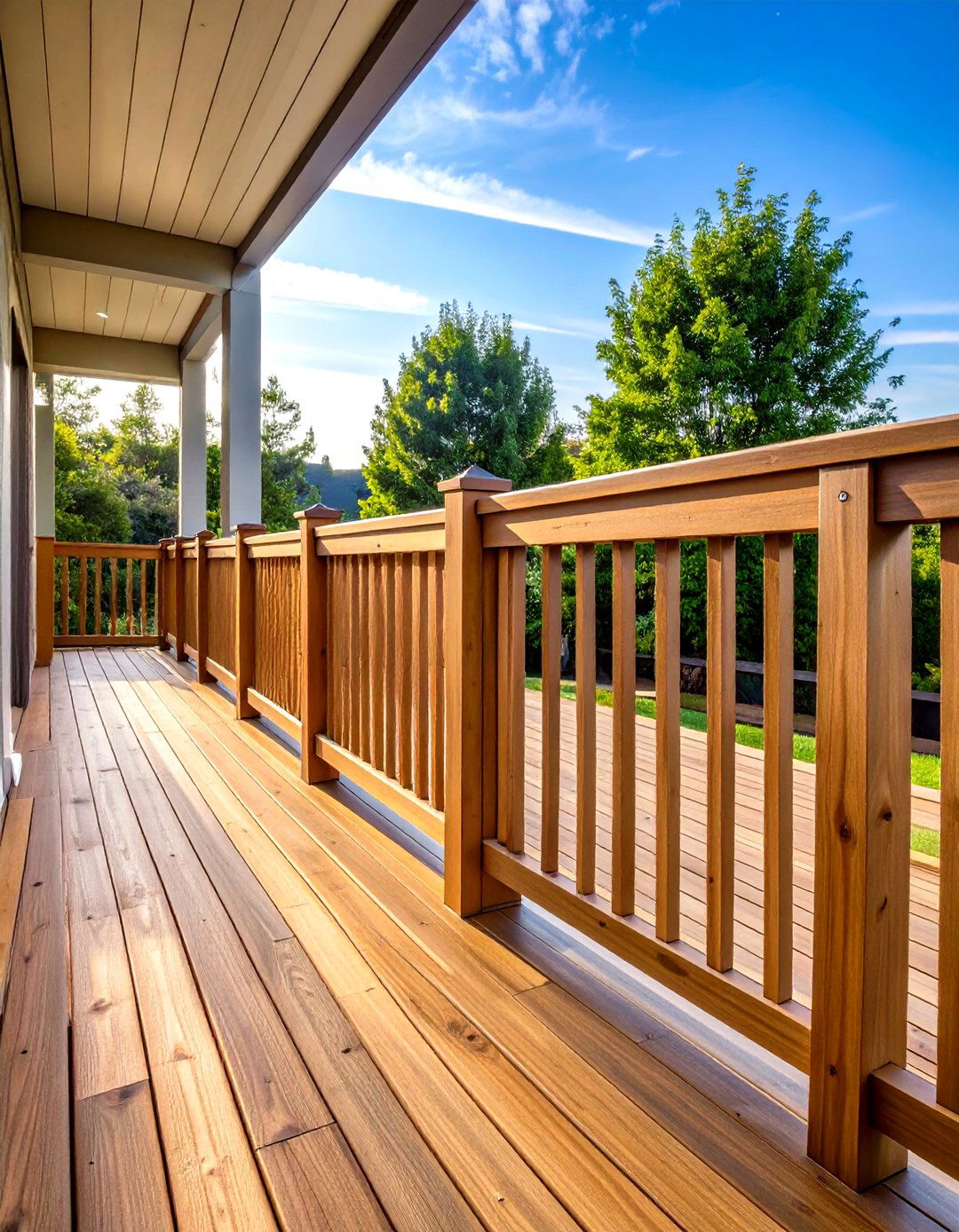
Pressure-treated wood deck railing systems provide an affordable, durable solution for safety-conscious homeowners. Pressure-treated wood is a popular choice for DIY wood deck railings and decking due to its many advantages. Its treatment process enhances the wood's ability to resist rot and insect damage, ensuring that your deck remains sturdy and long-lasting, even in challenging weather conditions. This wood deck railing option offers excellent value without compromising quality, making it accessible for various budgets. The chemical treatment process protects against rot and insect damage, extending the railing's lifespan significantly. Pressure-treated wood deck railings can be painted or stained to achieve desired aesthetics while maintaining their protective properties. Regular maintenance through staining or sealing helps preserve the wood's appearance and extends its service life.
5. Redwood Deck Railing Construction
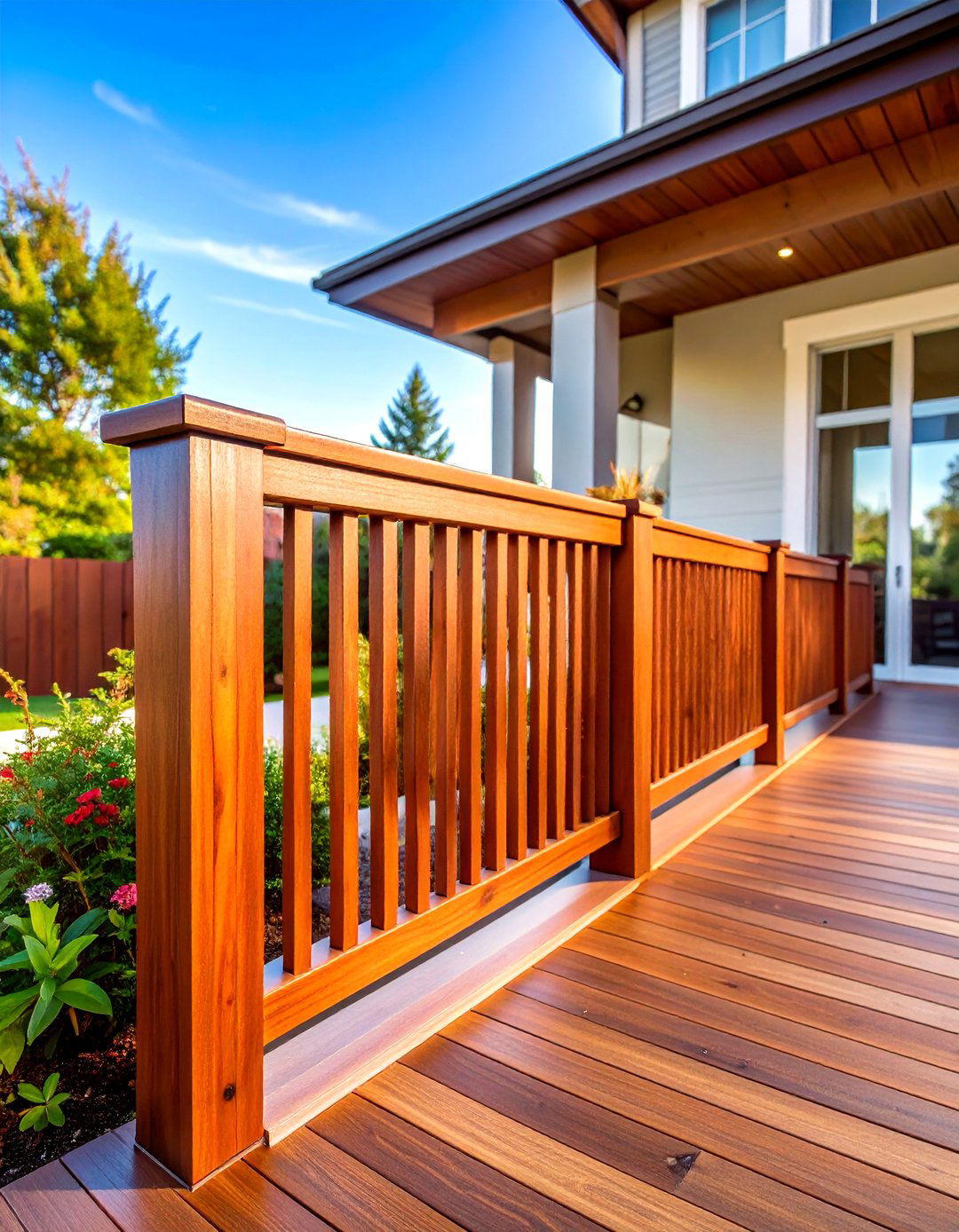
Redwood wood deck railing construction represents premium craftsmanship with exceptional natural properties for outdoor use. Redwood, another premium deck wood, is easy to work with, naturally decay- and insect-resistant, and rugged enough to avoid warping, checking, and splitting. Because of its open-celled structure, redwood contains little to no pitch or resins, and maintains its natural beauty and structural integrity with easy maintenance. The distinctive rich red color of this wood deck railing material creates stunning visual impact that complements various landscaping styles. Redwood's stability makes it ideal for intricate railing designs and detailed woodwork. While more expensive than other options, redwood wood deck railings offer superior longevity and require minimal maintenance, making them a worthwhile investment for discerning homeowners seeking premium outdoor living solutions.
6. Wood Deck Railing Lattice Pattern

Wood deck railing lattice patterns combine traditional charm with functional privacy screening for enhanced outdoor comfort. Add lattice-style railings that have intricate patterns carved into them. These will have a traditional and nostalgic appeal while adding to the charm of your place. This decorative wood deck railing style features interwoven wooden strips creating diamond or square patterns that filter views while maintaining airflow. The lattice design works exceptionally well as a trellis for climbing plants, adding natural greenery to your deck environment. Installation involves mounting pre-fabricated lattice panels or creating custom patterns using thin wooden strips. This wood deck railing approach offers excellent versatility, working equally well in cottage, traditional, and transitional architectural styles while providing moderate privacy and visual interest.
7. Sunburst Wood Deck Railing Design
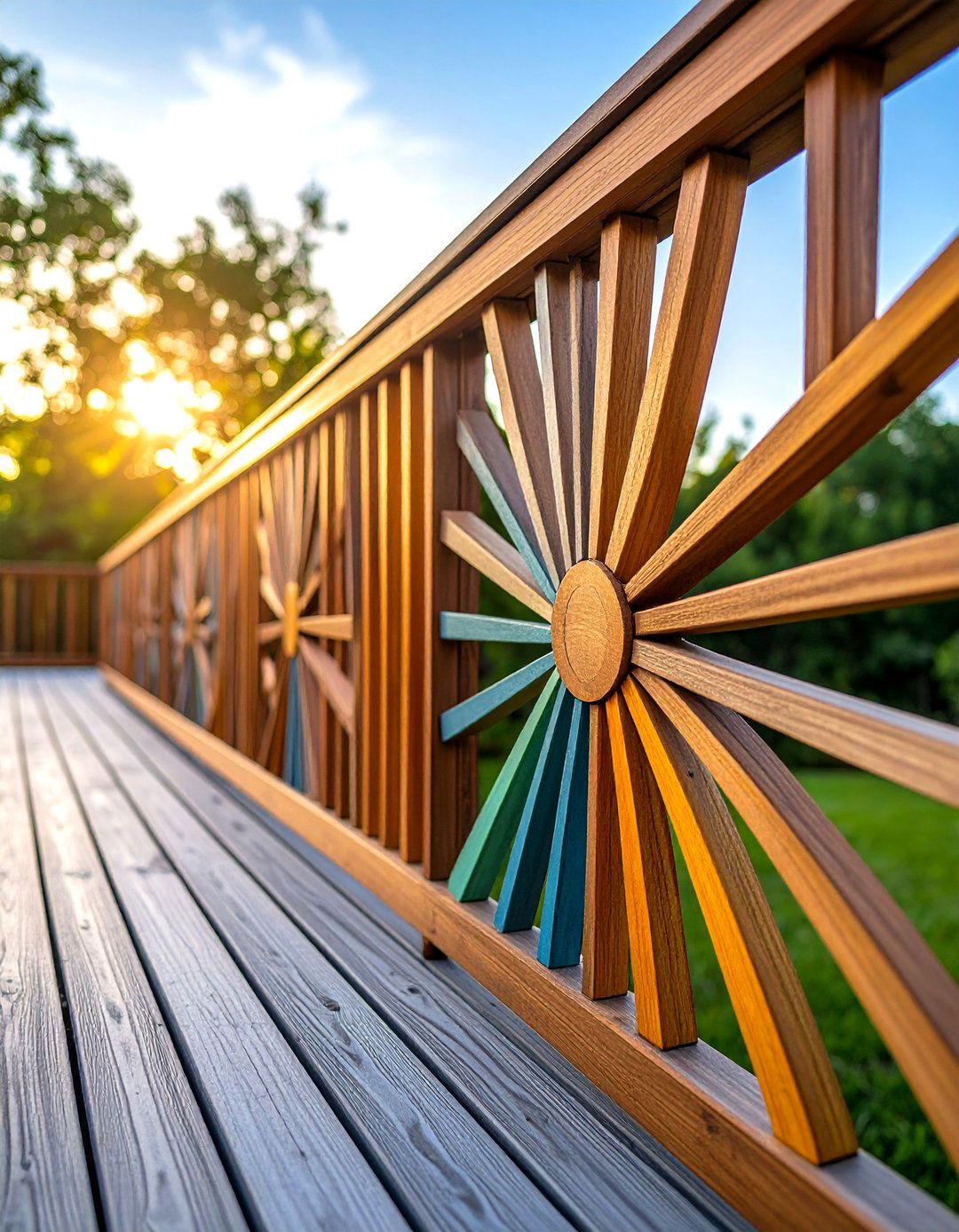
Sunburst wood deck railing designs create stunning focal points through radiating wooden elements that mimic natural sun patterns. The design that made the most sense was to go from center to each upper corner and then space everything else out in equal distances between those points. This artistic wood deck railing style features wooden pickets arranged in radiating patterns, often with a circular center element representing the sun. The sunburst pattern adds dramatic visual interest while maintaining safety code compliance through proper spacing. Creating this wood deck railing requires careful planning and precise cutting to achieve symmetrical results. The best way to install a sunburst deck railing design is to build the panels containing the diagonal spindles separately and install the entire piece as one. This ensures that all of your angles will be equal. This decorative approach works well with craftsman and artistic home styles.
8. Chippendale Wood Deck Railing Style
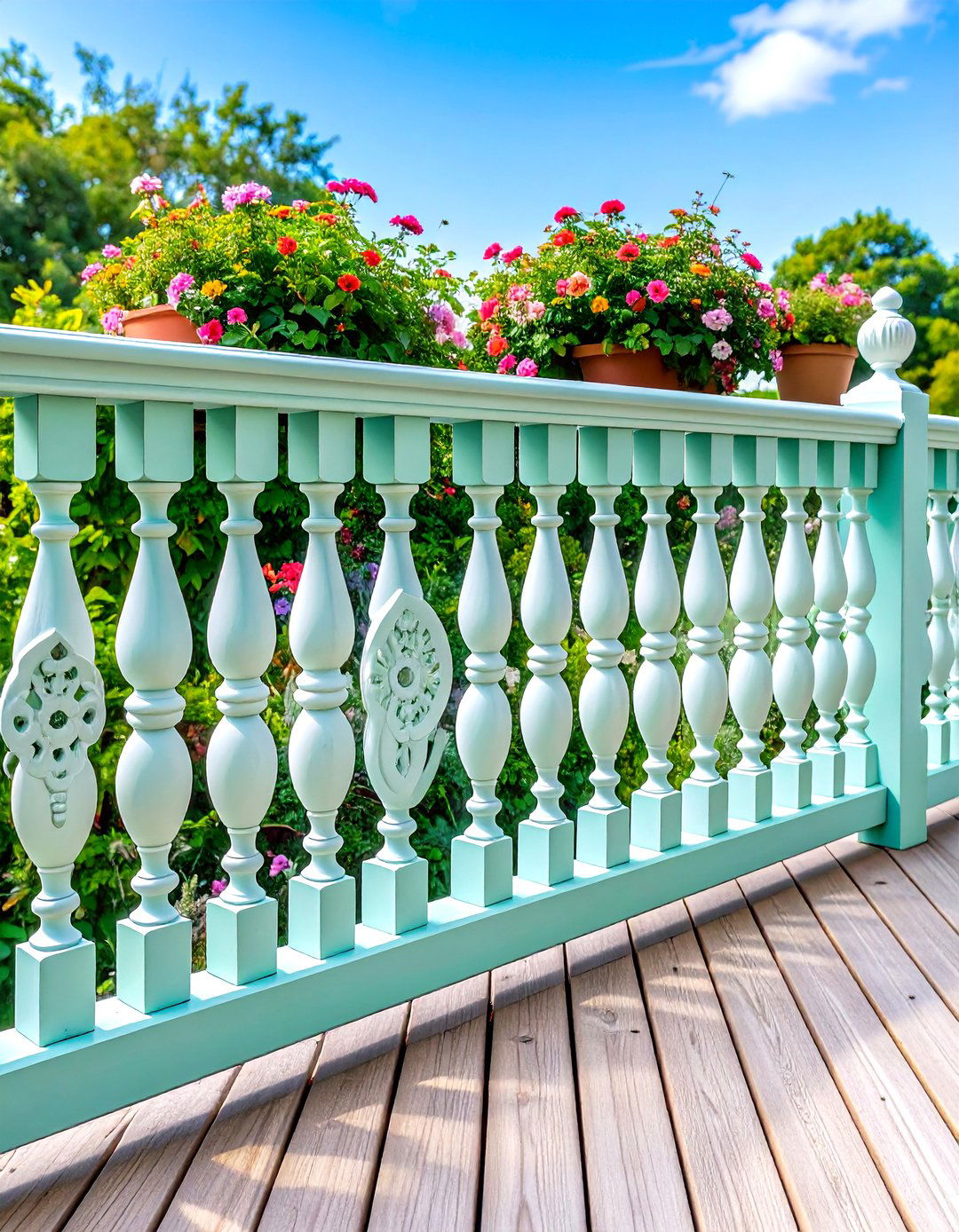
Chippendale wood deck railing styles bring historic elegance and sophisticated geometric patterns to contemporary outdoor spaces. This distinctive home railing features a classic X-eye Chippendale pattern that creates a striking focal point. The handcrafted wooden balustrade showcases a traditional X design with a captivating oval centerpiece, forming the signature 'eye' detail that's characteristic of authentic Chippendale porch railings. This ornate wood deck railing design draws inspiration from 18th-century English cabinetmaking, featuring intricate patterns that combine Chinese architectural influences with European craftsmanship. Modern manufacturing techniques make these elaborate designs more accessible through CNC cutting and prefabricated panels. Chippendale wood deck railings work particularly well with formal architectural styles but can adapt to contemporary settings through simplified interpretations of the classic patterns.
9. Wood Deck Railing with Built-in Benches
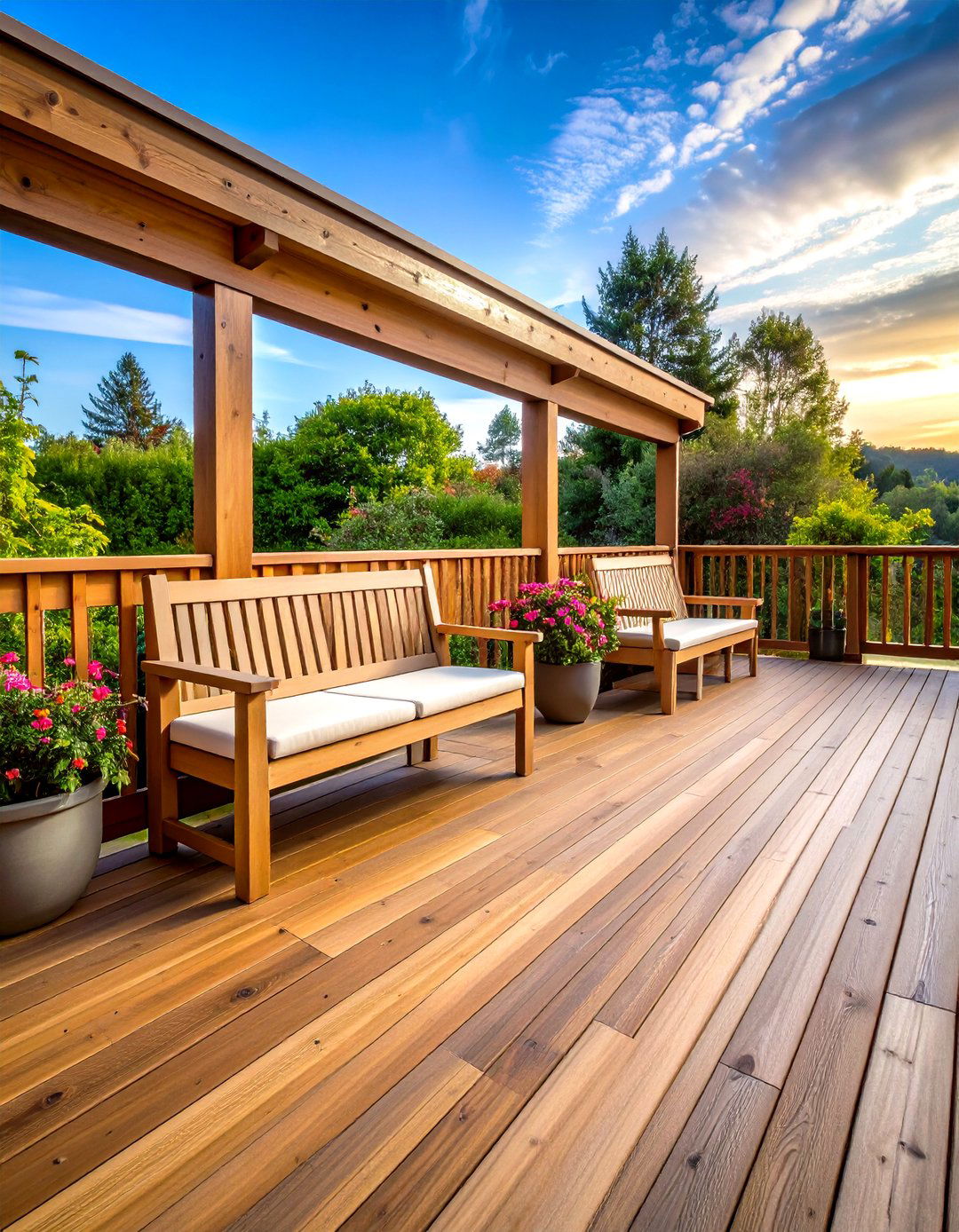
Wood deck railing with built-in benches maximizes functionality by combining safety features with comfortable seating solutions. This inviting deck railing design cleverly combines a 4×6 beam structure with integrated bench seating, creating both safety and functionality. The robust construction features horizontal 4×6 beams serving as the top rail and bench support, complemented by sturdy vertical posts, offering an aesthetic that appeals to outdoor living enthusiasts. This multifunctional wood deck railing approach transforms perimeter barriers into valuable entertaining space. The bench integration requires careful structural planning to ensure adequate support for both safety and seating loads. Additional features like storage compartments can be incorporated beneath bench seating. This wood deck railing design works excellently for smaller decks where space efficiency is crucial, while providing comfortable gathering areas for family and guests.
10. Rustic Branch Wood Deck Railing
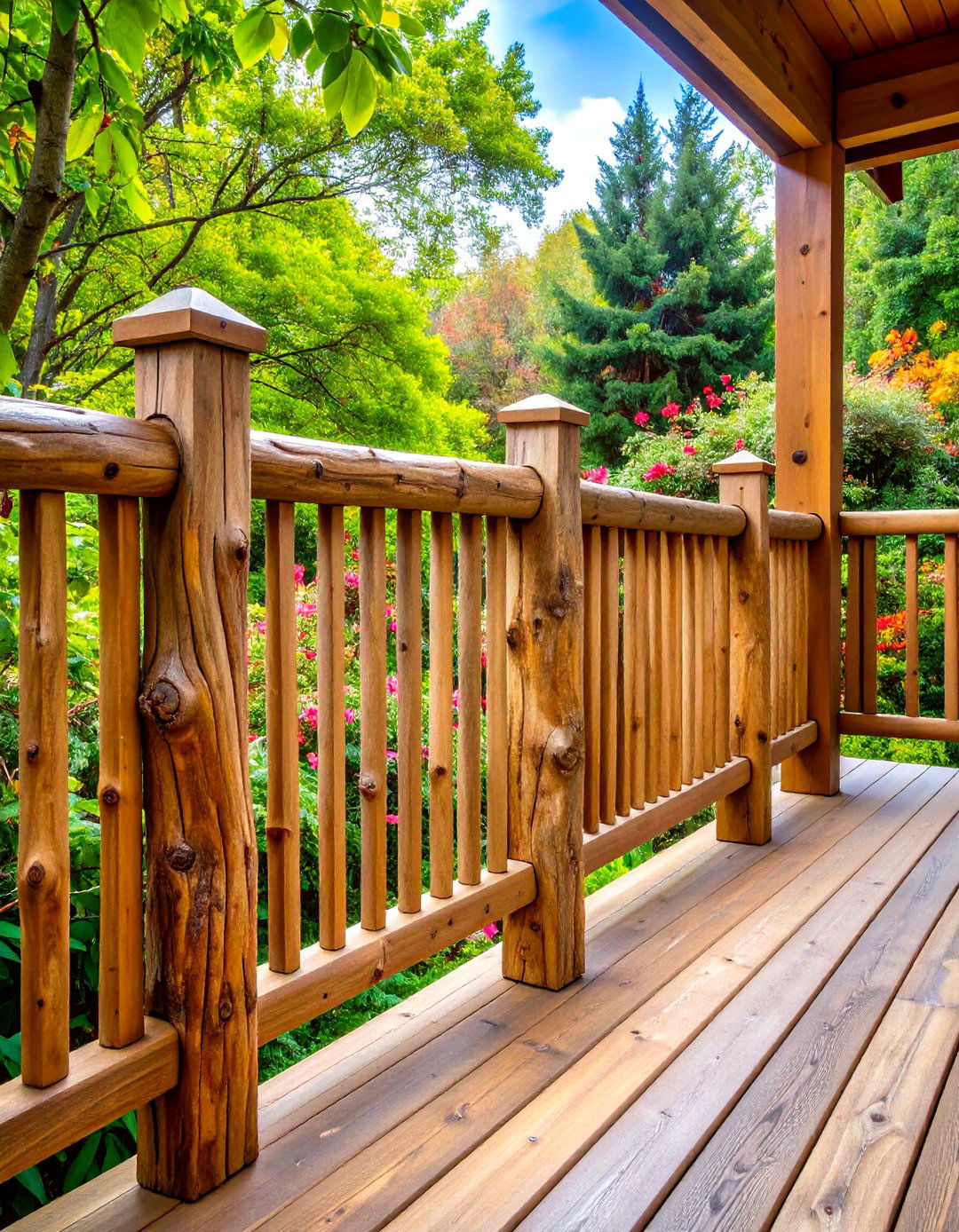
Rustic branch wood deck railing creates organic, natural barriers using unprocessed wooden elements that celebrate nature's beauty. Use natural branches or logs for a rustic and organic appeal to your deck railing ideas. These will be very durable and will offer a unique and warm ambiance to your decks. This distinctive wood deck railing style incorporates actual tree branches, logs, or deliberately rough-hewn lumber to achieve an authentic woodland aesthetic. The natural variations in branch thickness and curvature create one-of-a-kind railings that complement cabin, lodge, and rustic home styles. Installation requires careful selection of appropriately sized branches and proper treatment to prevent insect infestation and decay. This wood deck railing approach works particularly well in natural settings surrounded by trees and landscaping, creating seamless transitions between built and natural environments.
11. Wood Deck Railing Privacy Screens

Wood deck railing privacy screens provide enhanced seclusion while maintaining the natural beauty of wooden construction materials. Artfully designed wooden privacy screen patio rails blend form and function, featuring an elegant pattern of offset boards that create a sophisticated visual rhythm. This protective wood deck railing style uses closely spaced horizontal or vertical boards to block unwanted views while preserving airflow. The screening can incorporate decorative patterns or maintain clean, modern lines depending on architectural preferences. Strategic spacing prevents the railing from appearing too solid while achieving desired privacy levels. This wood deck railing design works exceptionally well for urban settings, pool areas, or decks facing neighboring properties where privacy is essential for comfortable outdoor living experiences.
12. Diagonal Pattern Wood Deck Railing
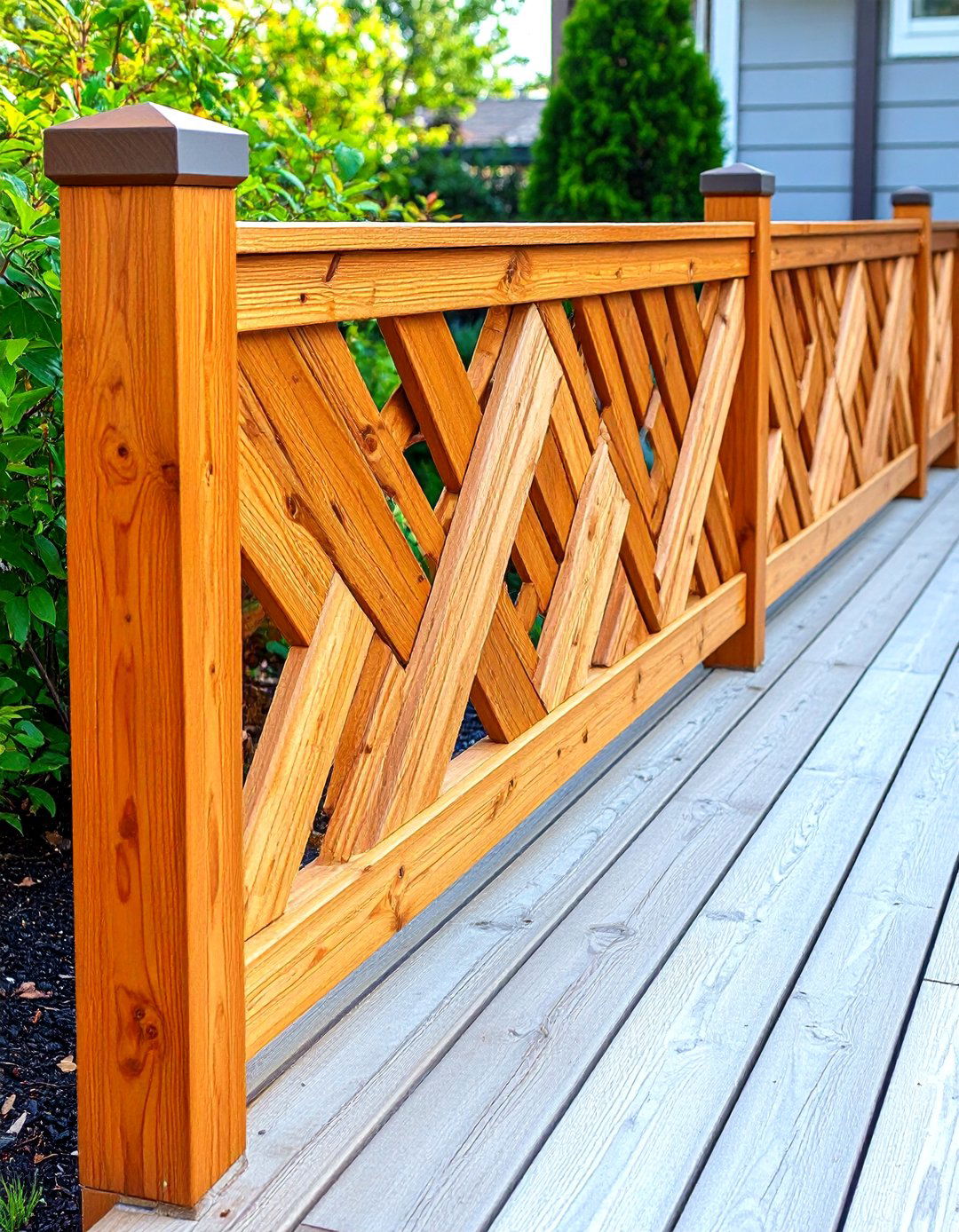
Diagonal pattern wood deck railing introduces dynamic visual movement through angled wooden elements that break traditional horizontal and vertical lines. Intersecting wooden slats create an eye-catching pattern in this distinctive railing design, where 1×4 boards angle from corner to corner in alternating directions. The framed alternating diagonal style adds visual interest and dynamic movement to outdoor spaces, making it an appealing choice for decks and patios. This energetic wood deck railing approach creates sophisticated geometric patterns while maintaining structural integrity and safety compliance. The diagonal orientation requires precise measurement and cutting to achieve consistent angles throughout the installation. Various patterns can be created including chevron, herringbone, or diamond arrangements. This wood deck railing style works particularly well with contemporary and transitional architectural designs that appreciate bold geometric elements.
13. Mixed Material Wood Deck Railing
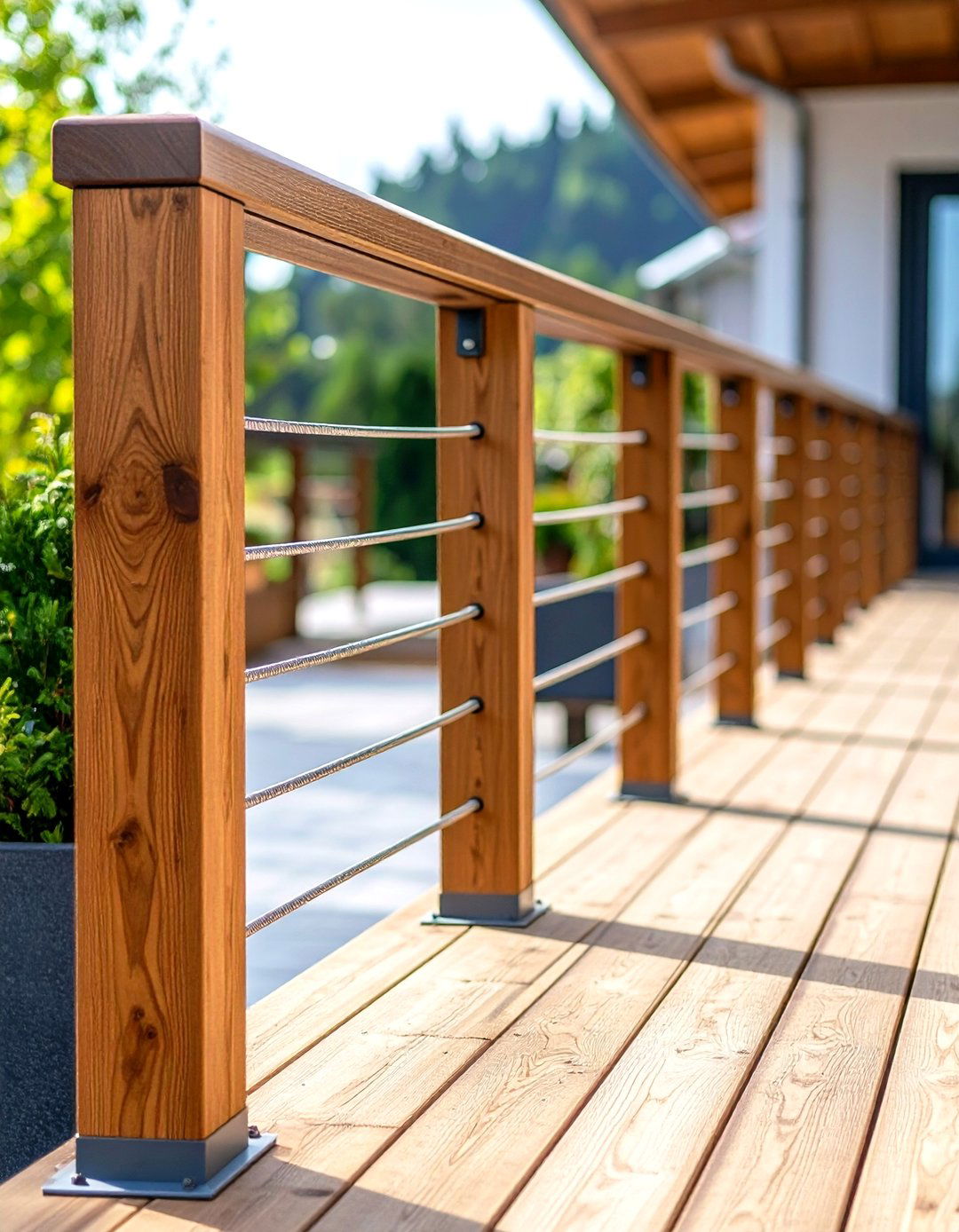
Mixed material wood deck railing combines the warmth of natural wood with the strength and modern appeal of metal elements. This minimalist design works equally well with porch railing or stair railing as it does as a deck rail design. Using wood and cable is also a low-maintenance design. The steel cables are durable and strong, and naturally strong woods like cedar or redwood will last for years untreated. This innovative wood deck railing approach features wooden posts and top rails paired with stainless steel cables, metal balusters, or wire mesh panels. The combination creates contemporary aesthetics while preserving natural wood character. Metal components provide enhanced durability and reduced maintenance requirements, while wood elements maintain visual warmth. This wood deck railing design works excellently with modern and transitional home styles, offering unobstructed views while ensuring safety and structural integrity.
14. Turned Baluster Wood Deck Railing
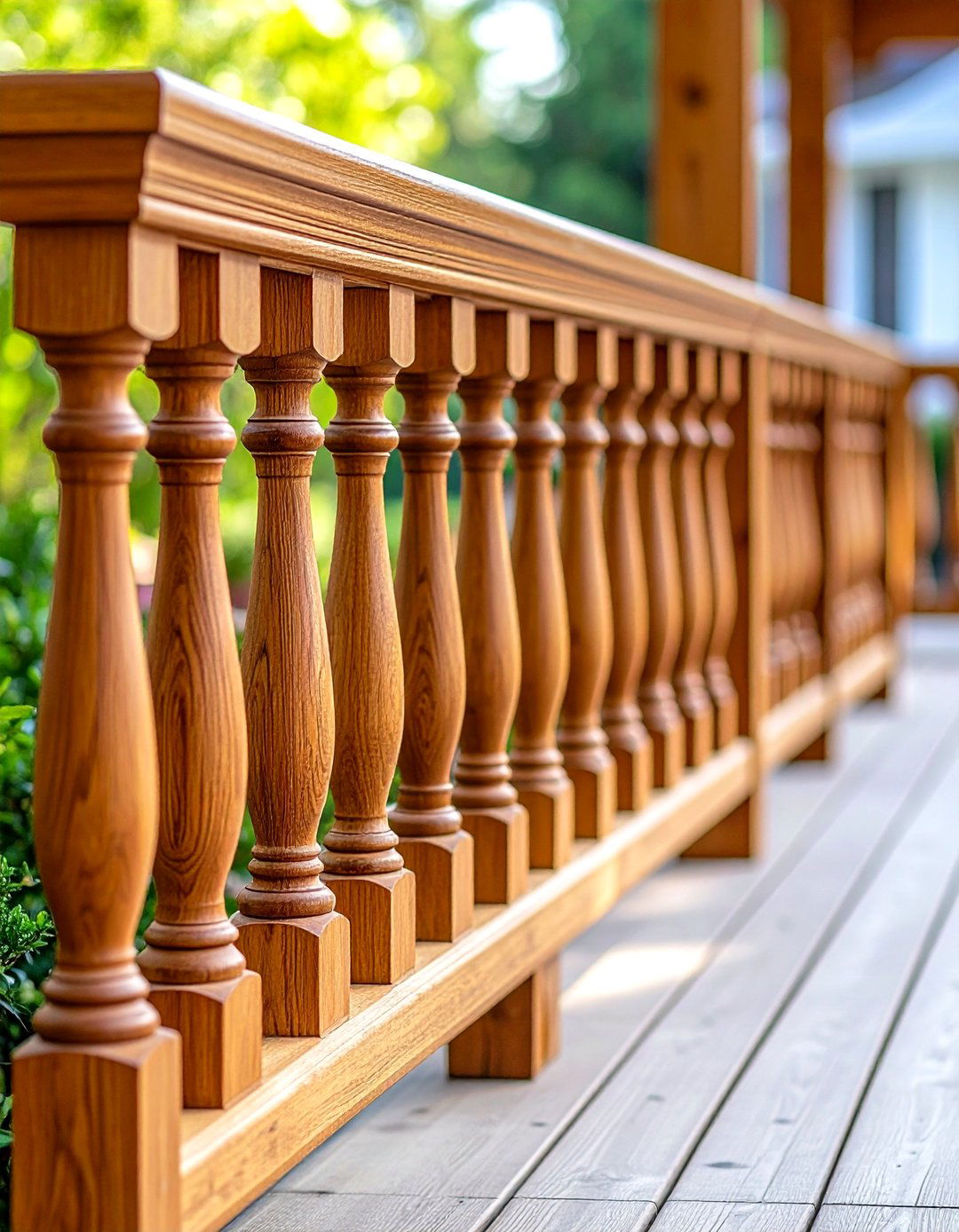
Turned baluster wood deck railing showcases traditional craftsmanship through elegantly shaped spindles that add classical architectural detail. Contemporary turned balusters are slim and slender with strong symmetry. This white patio railing idea and the matching posts complement the porch floored with pavers. This refined wood deck railing style features lathe-turned wooden spindles with decorative profiles ranging from simple to ornate designs. The turned elements can incorporate various traditional patterns including fluting, beading, and tapered sections. These decorative components work well with both painted and stained finishes, allowing customization to match home exteriors. Turned baluster wood deck railings complement colonial, Victorian, and craftsman architectural styles while adding timeless elegance to outdoor living spaces. Proper spacing ensures code compliance while maintaining the refined appearance of this classic railing style.
15. Wood Deck Railing Trellis Design
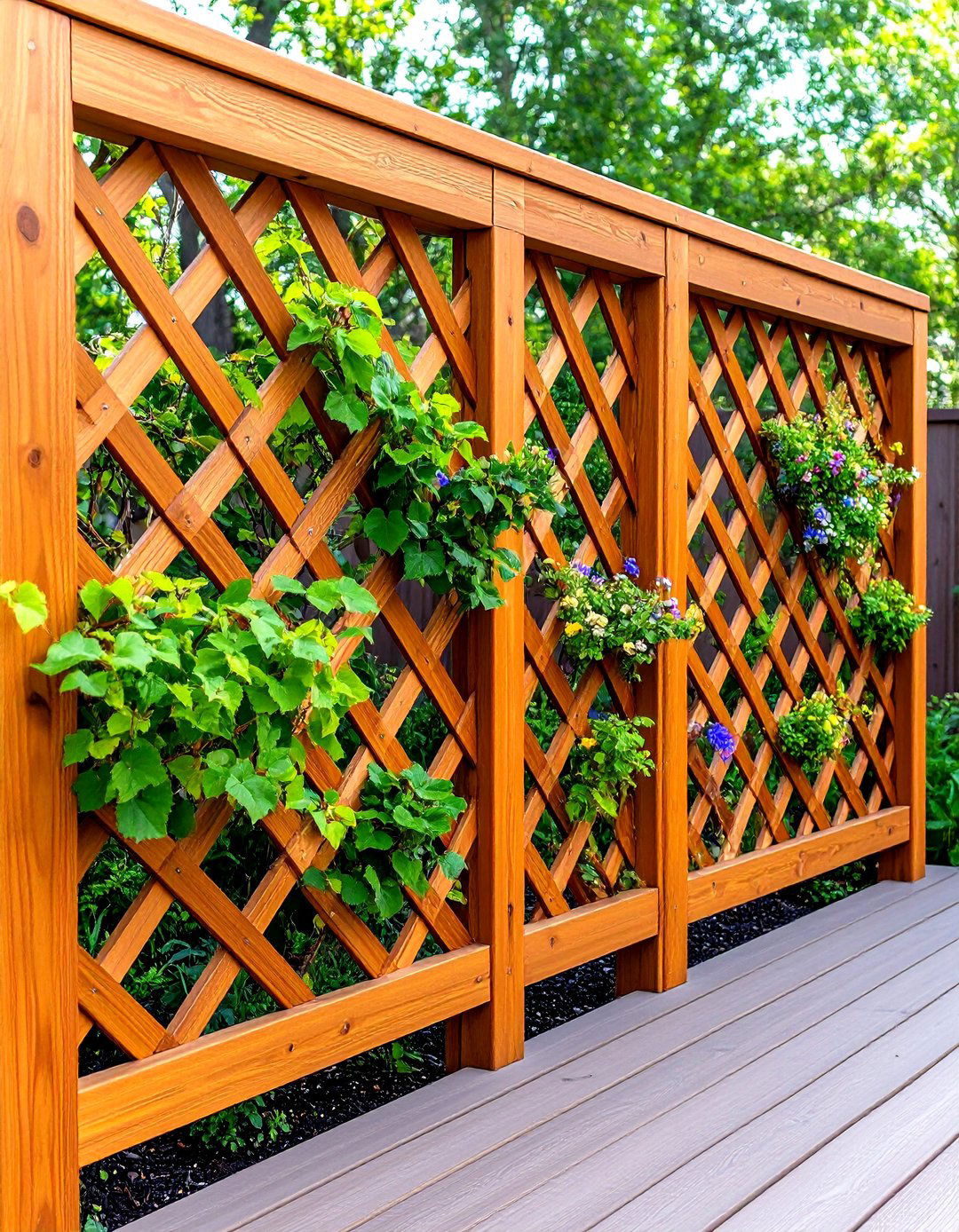
Wood deck railing trellis designs merge functional barriers with gardening opportunities, creating living walls that enhance outdoor environments. For this deck railing, a wooden railing with lattice pattern wooden slats will create a trellis for climbing plants. Morning Glory or Ivy are two easy to grow climbing plants that you could sow at the bottom of your new trellis deck railing to add greenery to your outdoor living space. This natural wood deck railing approach incorporates climbing plant support directly into the railing structure through lattice work, wire grids, or spaced slat arrangements. The design allows for seasonal changes as plants grow and bloom, creating dynamic living barriers. Proper plant selection ensures year-round interest while preventing structural damage from aggressive climbing species. This wood deck railing style works particularly well with garden-oriented homes and landscape designs that emphasize natural integration.
16. Herringbone Pattern Wood Deck Railing
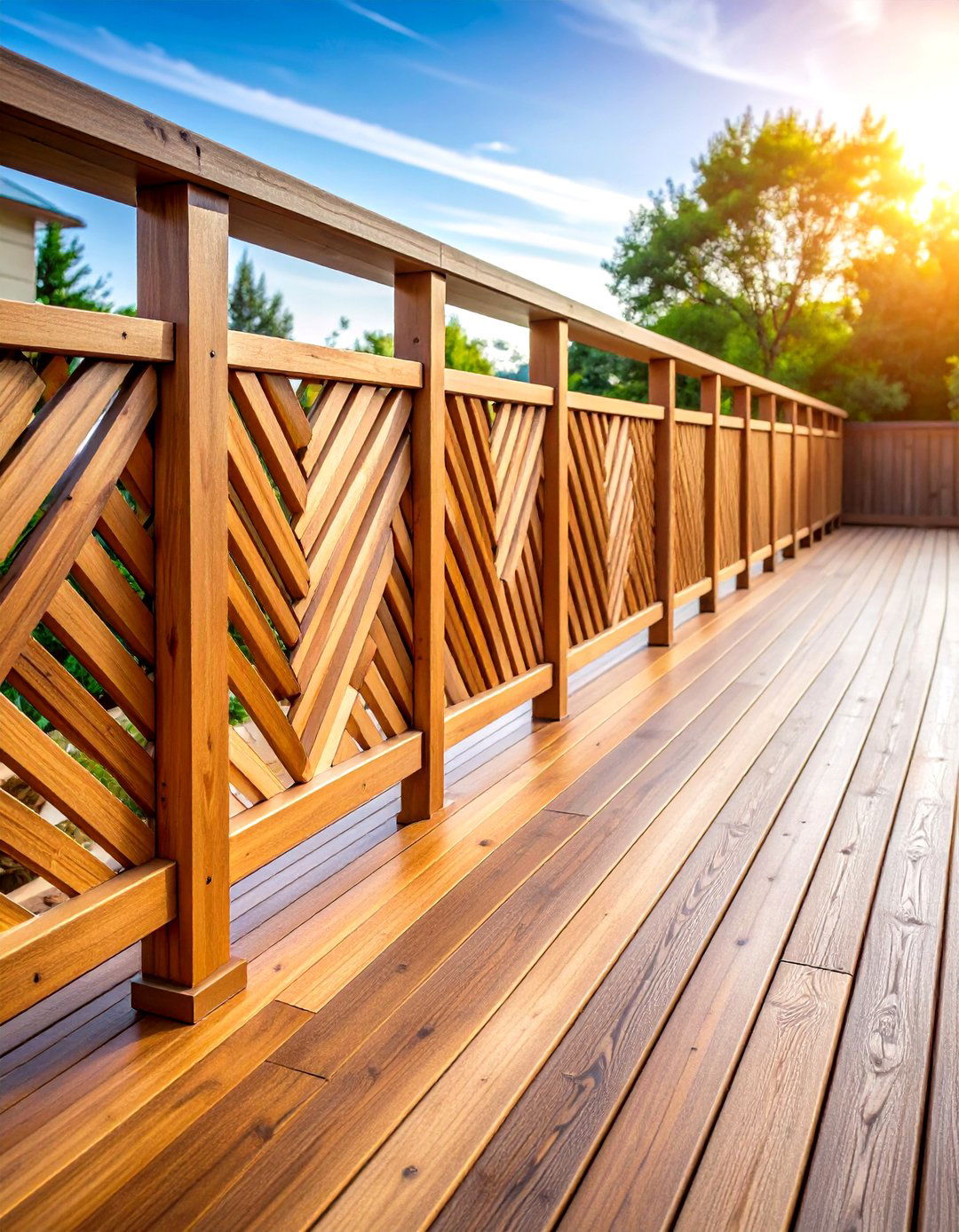
Herringbone pattern wood deck railing creates sophisticated visual interest through alternating diagonal wooden elements arranged in classic zigzag formations. Herringbone-patterned railings for decks will give your deck spaces a classic and modern appeal. These will add to the aesthetics of your place. This distinctive wood deck railing design features wooden slats or boards arranged in the traditional herringbone pattern, creating rich textural effects that catch light beautifully throughout the day. The alternating diagonal arrangement requires precise cutting and fitting to achieve clean, professional results. This wood deck railing pattern works particularly well with contemporary and transitional home styles that appreciate classic patterns presented in fresh ways. The geometric nature of herringbone patterns complements both painted and natural wood finishes, offering versatility in matching various architectural color schemes and materials.
17. Wood Deck Railing with Decorative Post Caps
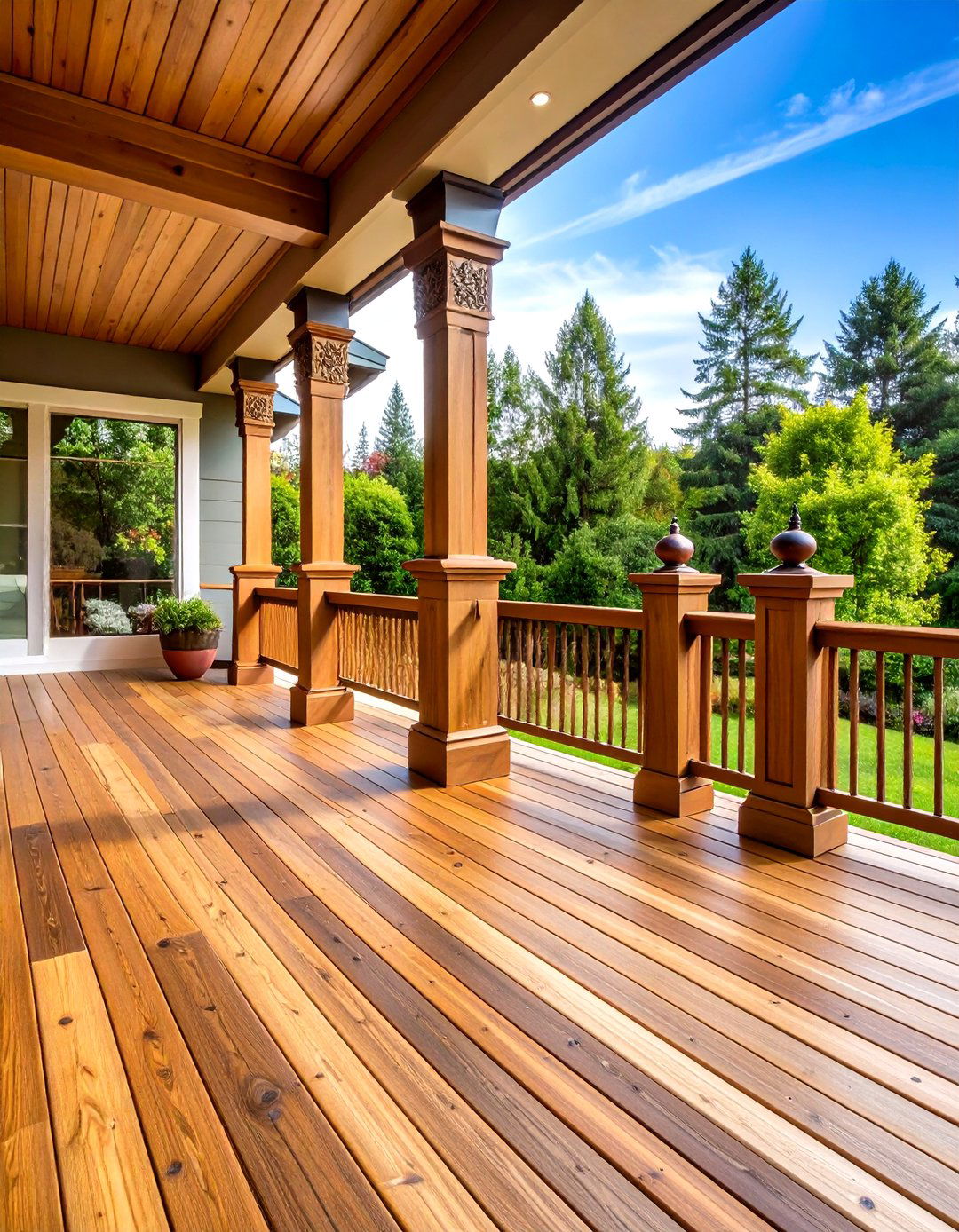
Wood deck railing with decorative post caps elevates standard designs through architectural details that create polished, finished appearances. Add a personal touch to your outdoor deck with decorative panels or custom inserts. Feature unique patterns, elegant crests, nature-inspired designs and more. Use these custom panels to create an eye-catching focal point or update your entire deck railing with decorative panels. This enhanced wood deck railing approach incorporates carved, turned, or shaped cap elements that crown vertical posts with style. Post caps can feature simple geometric shapes, ornate carved details, or modern minimalist forms depending on overall design goals. These decorative elements protect post tops from weather while adding visual sophistication. Various materials including matching wood, contrasting metal, or stone can create different aesthetic effects. This wood deck railing enhancement works with virtually any base design, transforming ordinary railings into custom architectural features.
18. Farmhouse Style Wood Deck Railing
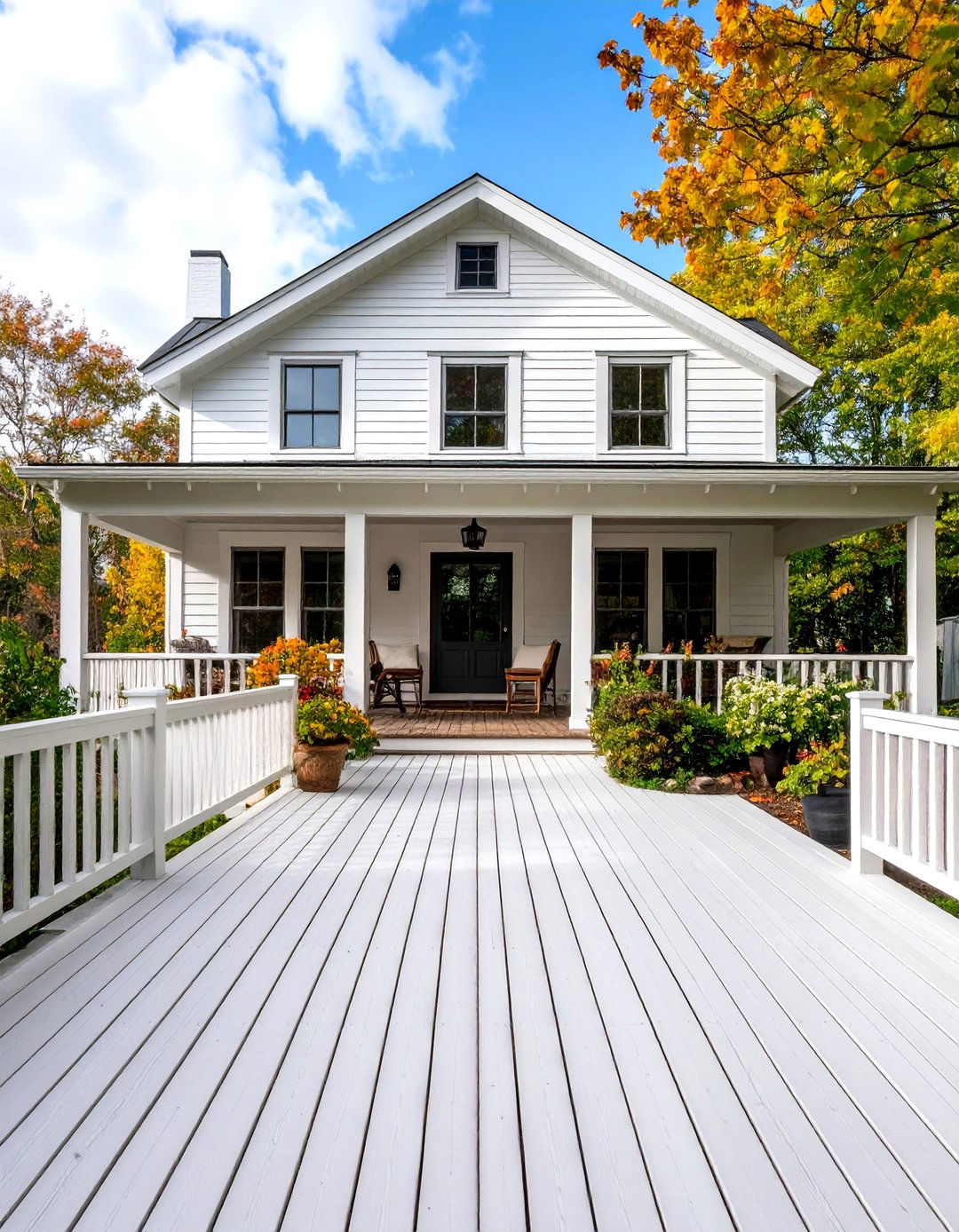
Farmhouse style wood deck railing emphasizes simplicity, functionality, and rustic charm through clean lines and natural materials. Add farmhouse charm to your porch with crisscross railings! Use thinner pieces to build the balustrade in four parts or two interlocking sections. It's a stylish way to give your porch a modern farmhouse feel. This popular wood deck railing style features simple horizontal or crisscross patterns that celebrate rural architectural traditions while maintaining contemporary appeal. The design typically uses wider boards, painted white or stained natural finishes, and straightforward construction methods. X-pattern configurations and horizontal plank arrangements are common variations that enhance the rustic aesthetic. This wood deck railing approach works exceptionally well with modern farmhouse, cottage, and country home styles, creating welcoming outdoor spaces that emphasize comfort and simplicity over ornate decoration.
19. Multi-Level Wood Deck Railing Design
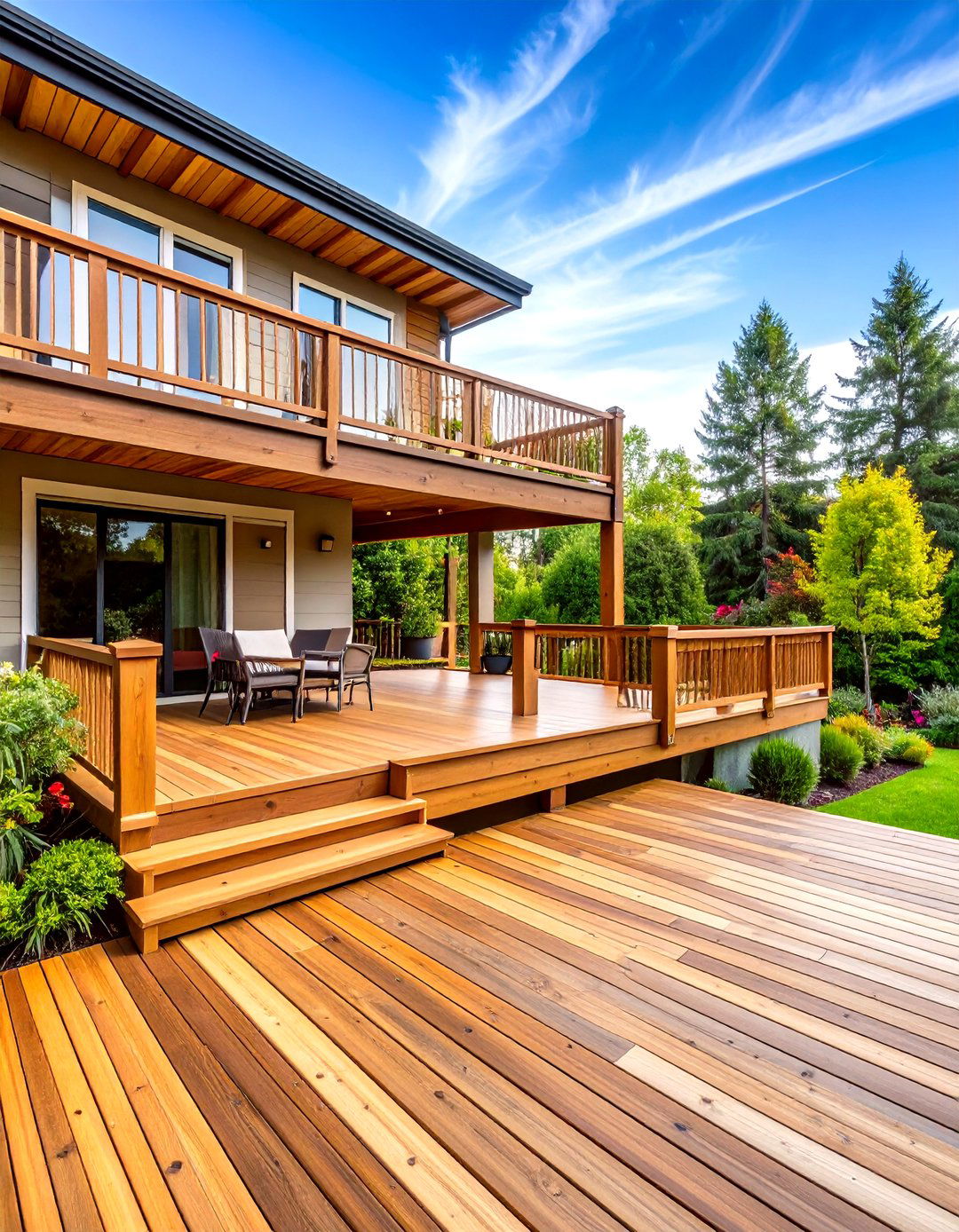
Multi-level wood deck railing designs accommodate complex deck configurations while maintaining visual continuity across different elevations and sections. Each material sits at a different depth from the posts, with wood closest, metal in the middle, and glass panels facing out. This design works best for large decks where the pattern can fully show. This sophisticated wood deck railing approach requires careful planning to ensure consistent height, spacing, and aesthetic flow between different deck levels. Transition elements like angled sections or step-down configurations help connect various elevations smoothly. The design can incorporate different wood species or finishes to define distinct areas while maintaining overall coherence. This wood deck railing style works particularly well with large, complex deck systems that serve multiple functions and accommodate various outdoor activities across different zones.
20. Wood Deck Railing with Integrated Lighting
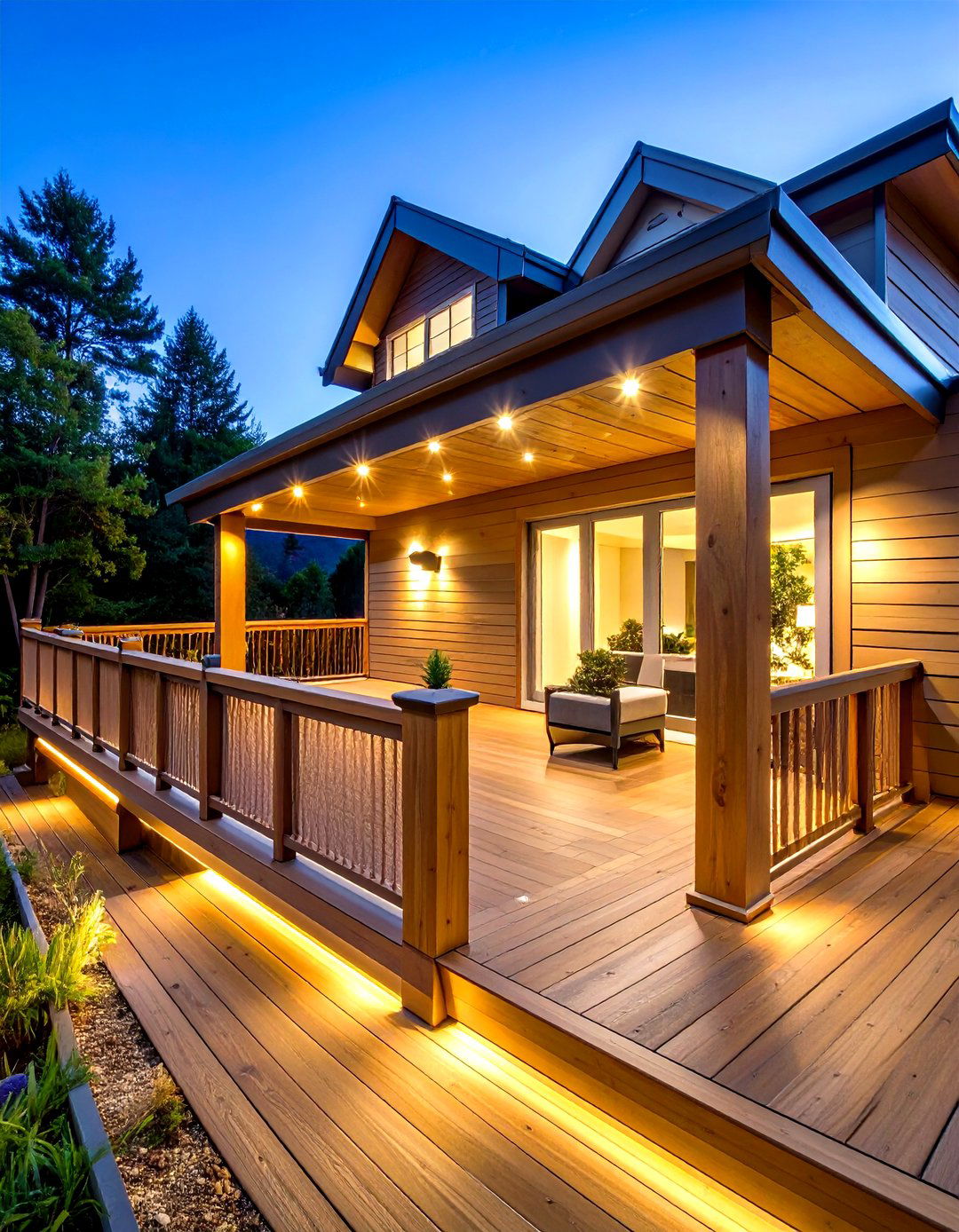
Wood deck railing with integrated lighting combines safety, ambiance, and functionality through carefully planned illumination systems built into wooden structures. Built-in LED or solar lights look great and add safety too. Try plug-in lights or string lights to achieve the look you want. This advanced wood deck railing design incorporates LED strips, post cap lights, or recessed fixtures directly into wooden components, creating beautiful evening atmospheres while enhancing safety. The lighting can highlight architectural details, provide pathway illumination, or create dramatic accent effects. Low-voltage systems ensure safe operation while solar options offer environmentally friendly alternatives. Proper planning during construction ensures clean wire routing and weather protection. This wood deck railing enhancement transforms outdoor spaces into usable evening environments, extending deck enjoyment well into nighttime hours while maintaining the natural beauty of wooden construction.
Conclusion:
Wood deck railings offer remarkable versatility for enhancing outdoor living spaces through diverse designs, materials, and construction approaches. From classic picket styles to innovative mixed-material systems, these essential safety features can dramatically transform deck aesthetics while providing necessary protection. The natural beauty, customization potential, and availability of various wood species ensure that homeowners can find perfect solutions for any architectural style or budget. Careful consideration of local building codes, material selection, and maintenance requirements will ensure long-lasting, beautiful results that enhance property value and outdoor enjoyment for years to come.



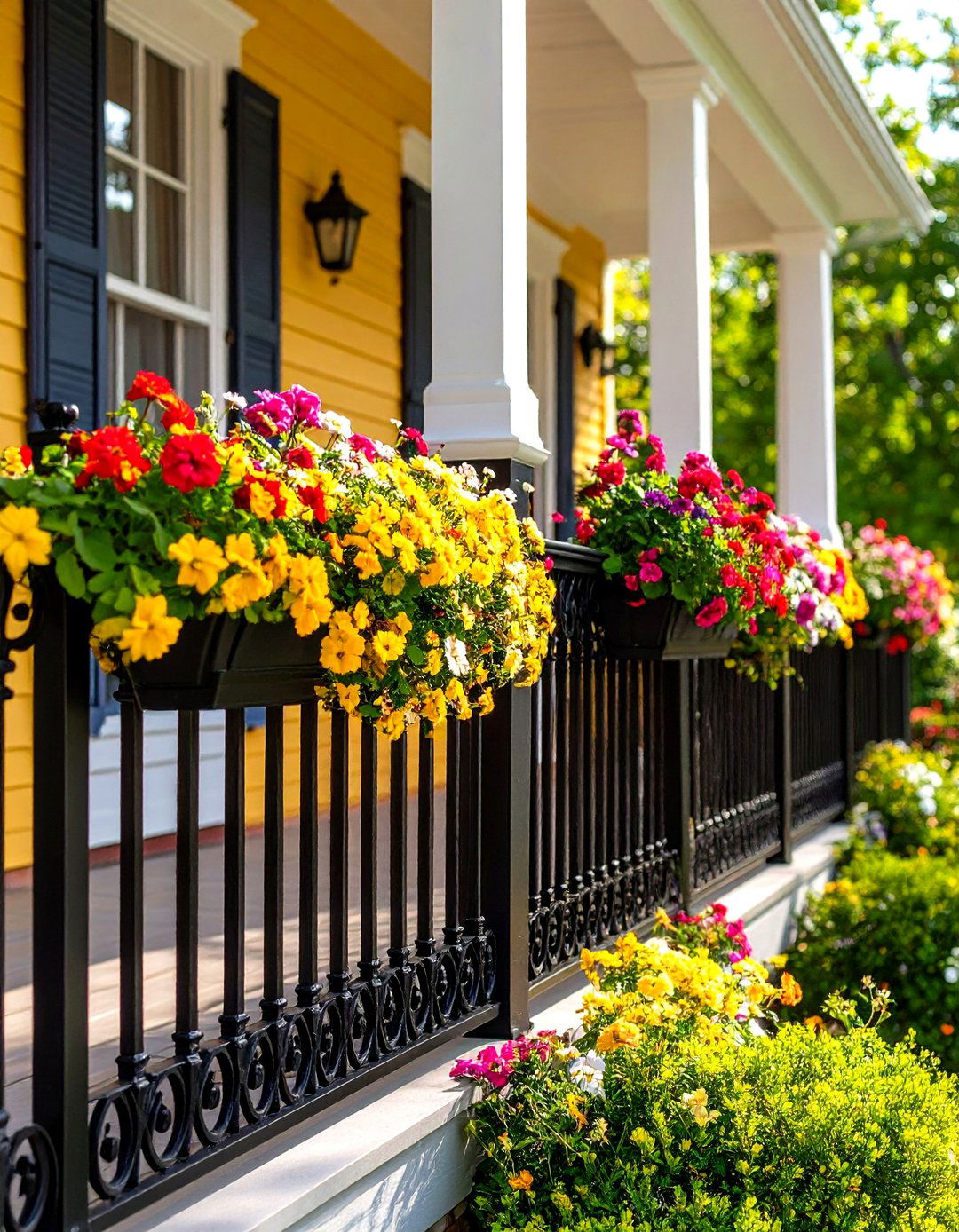
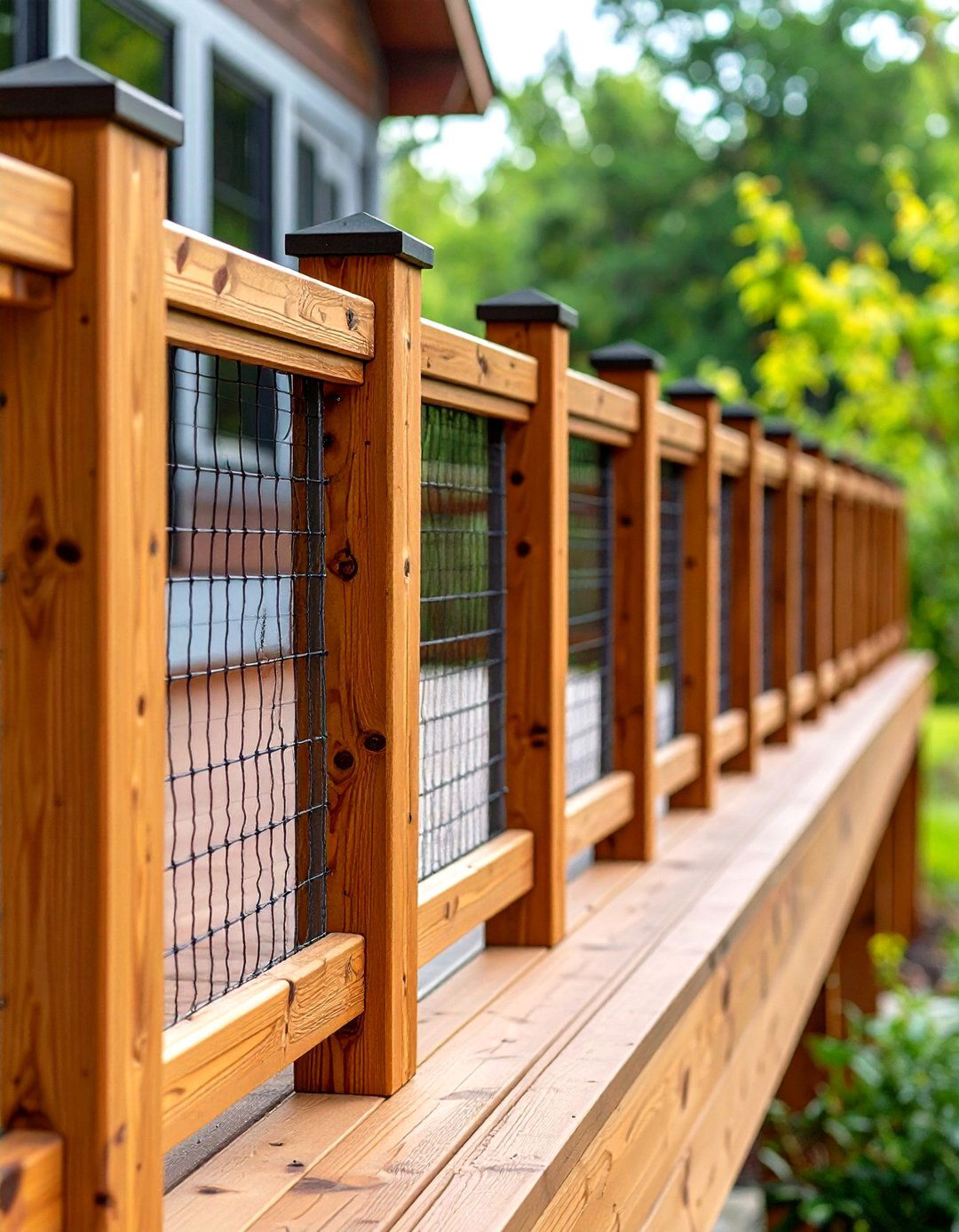
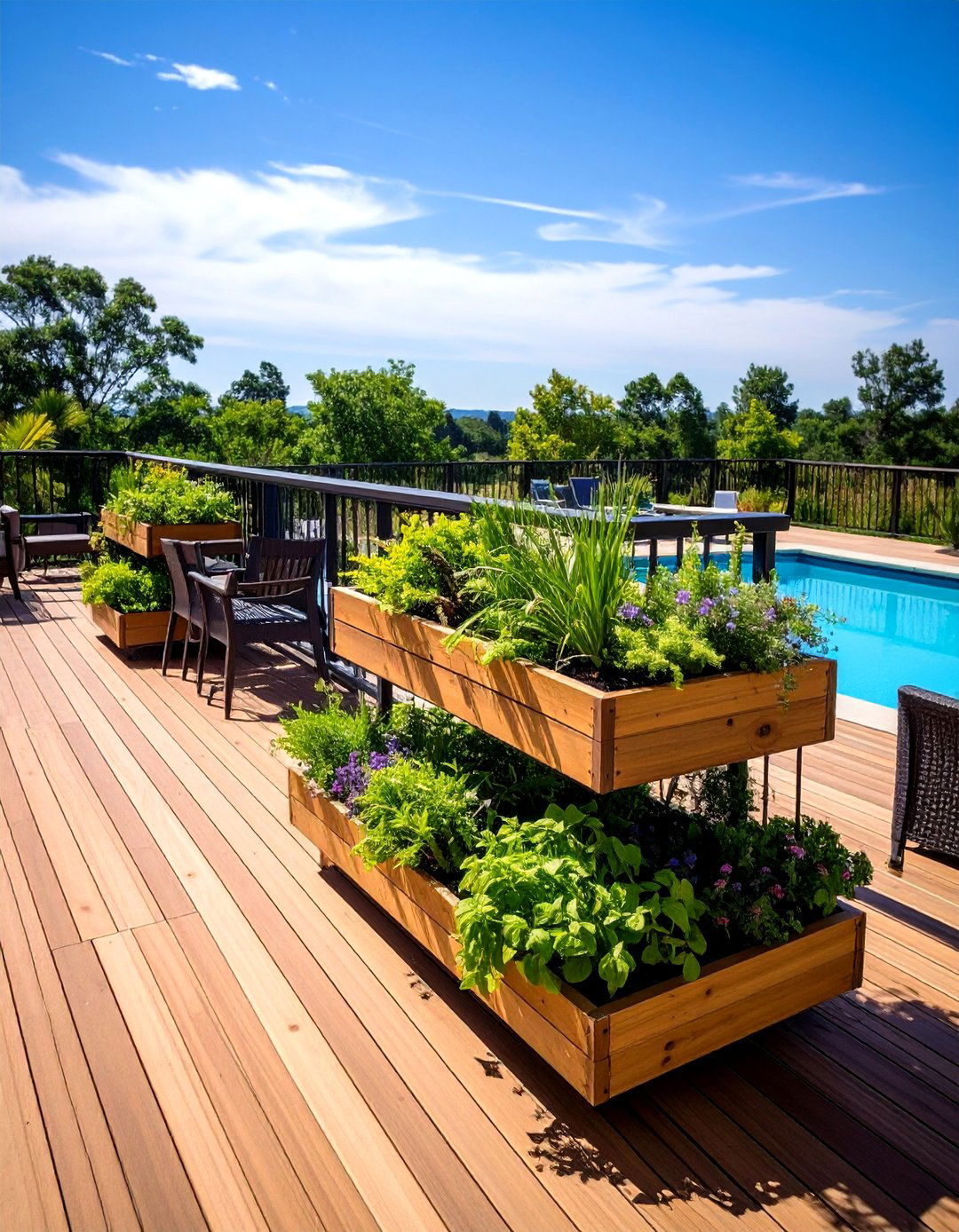
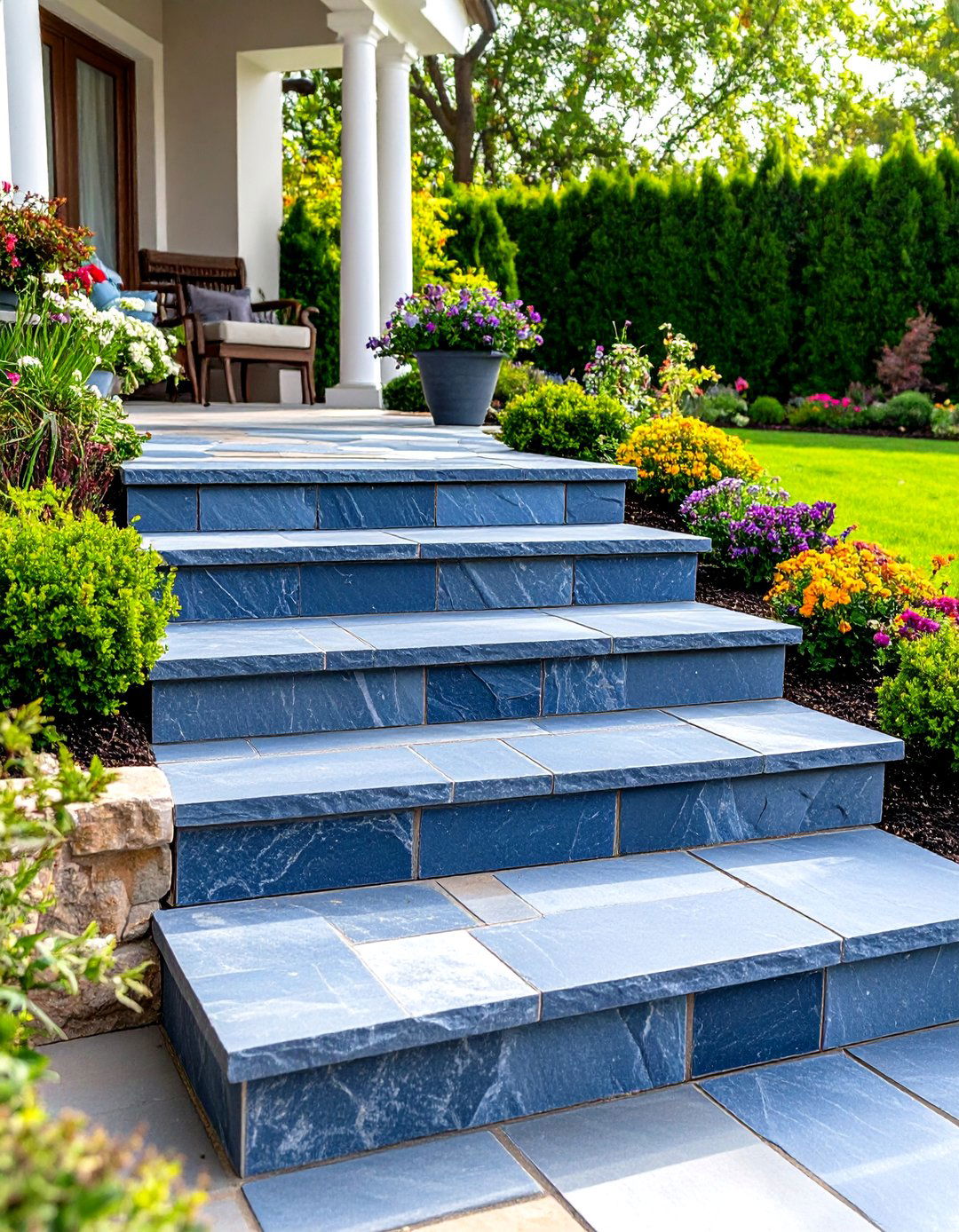

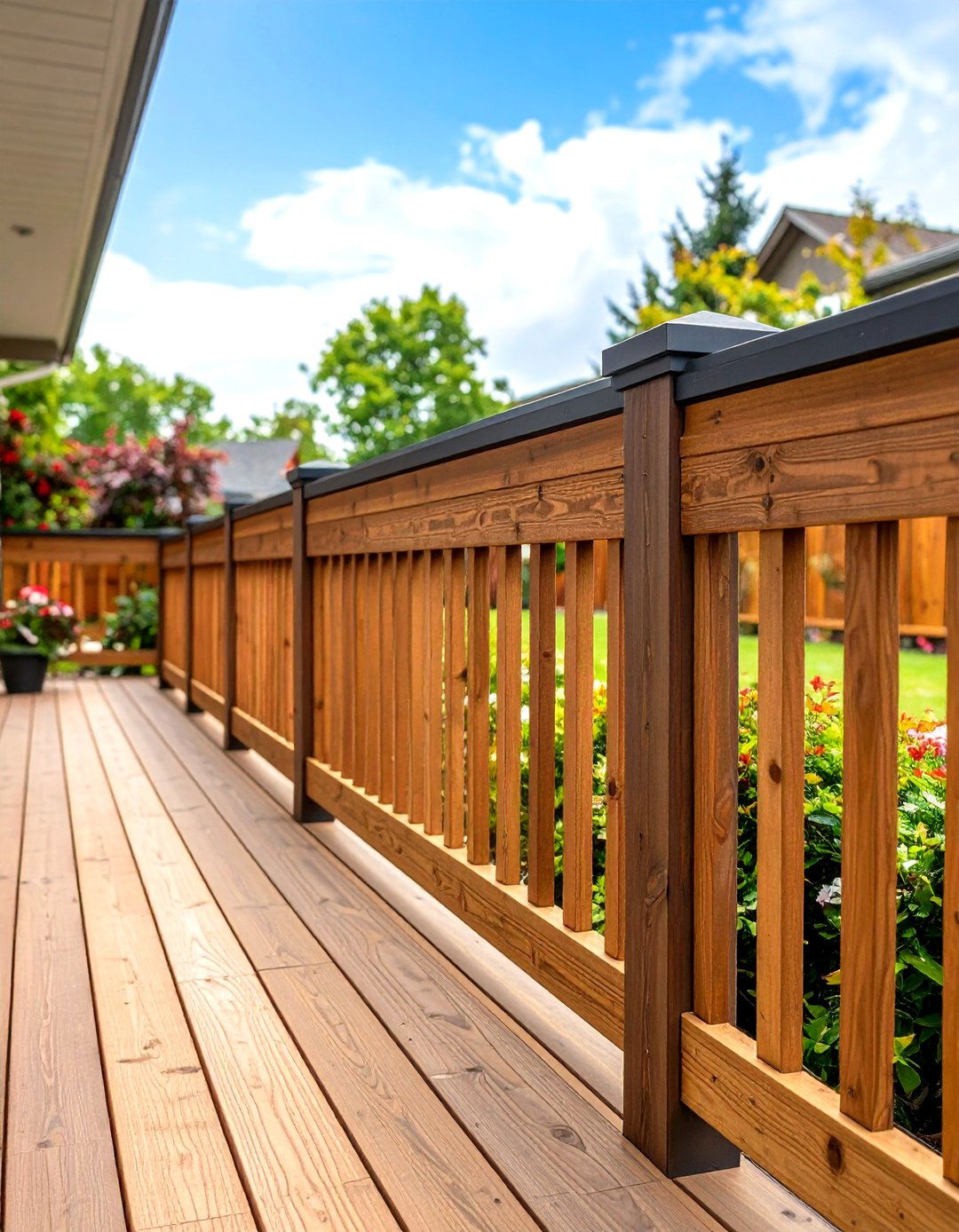

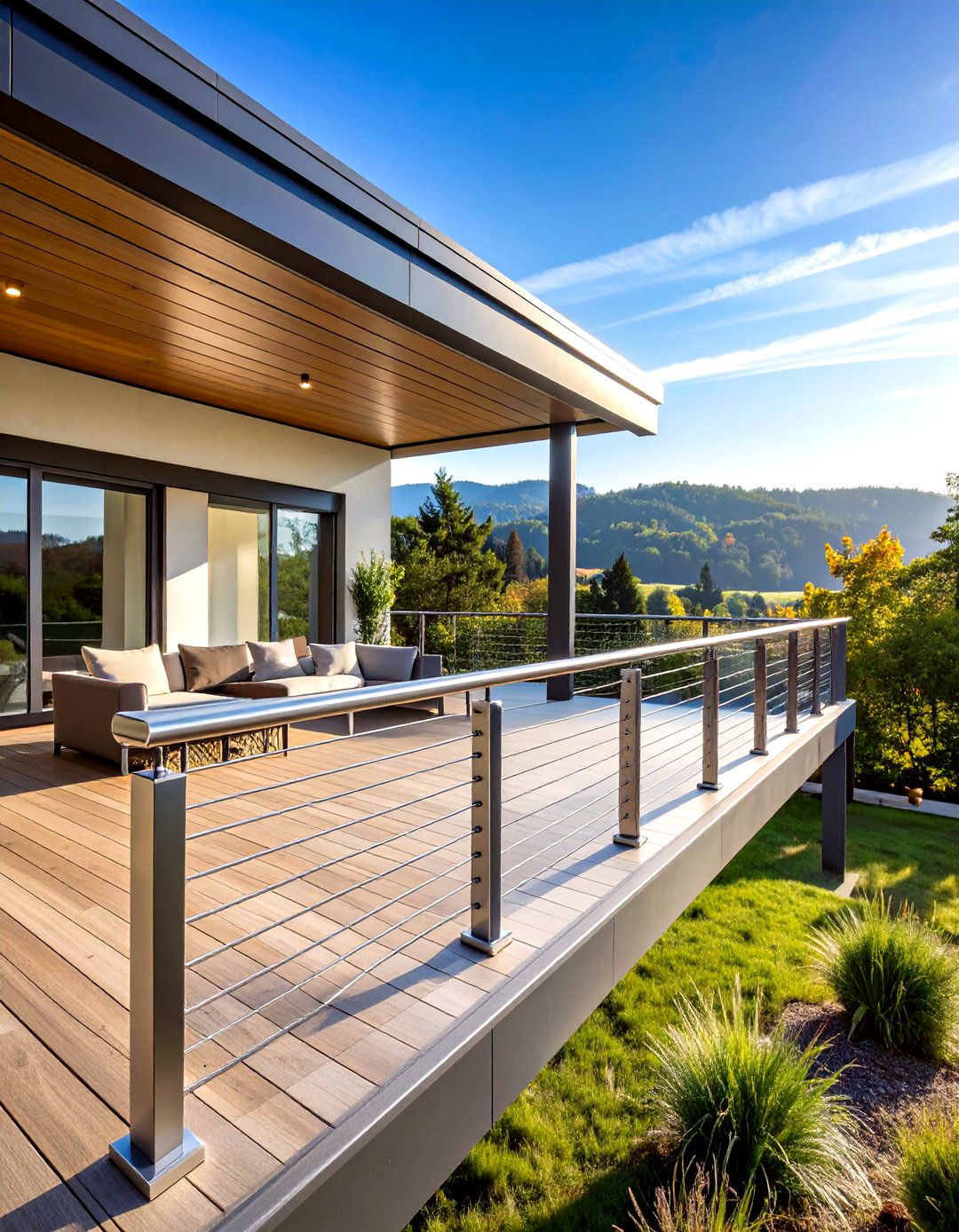
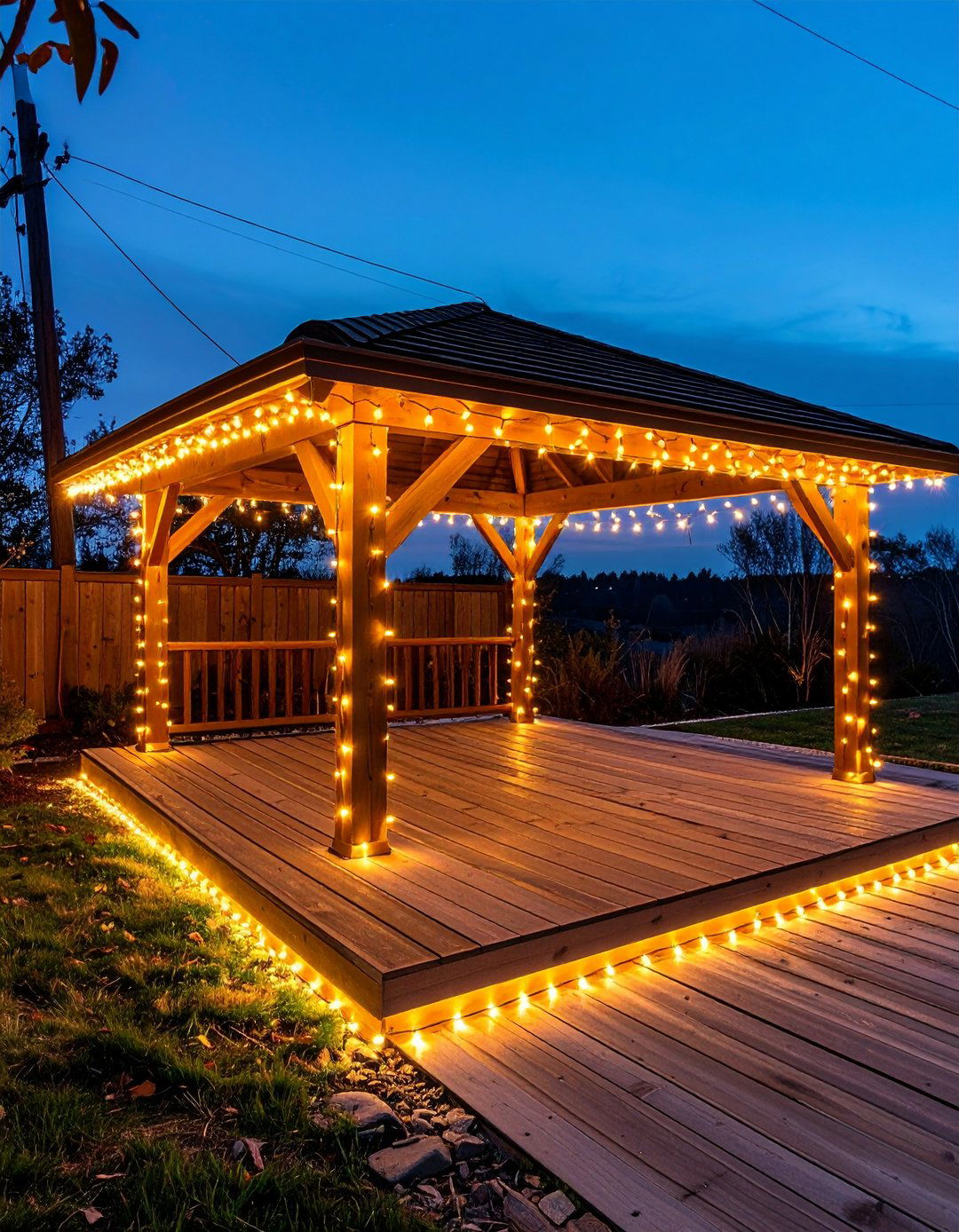
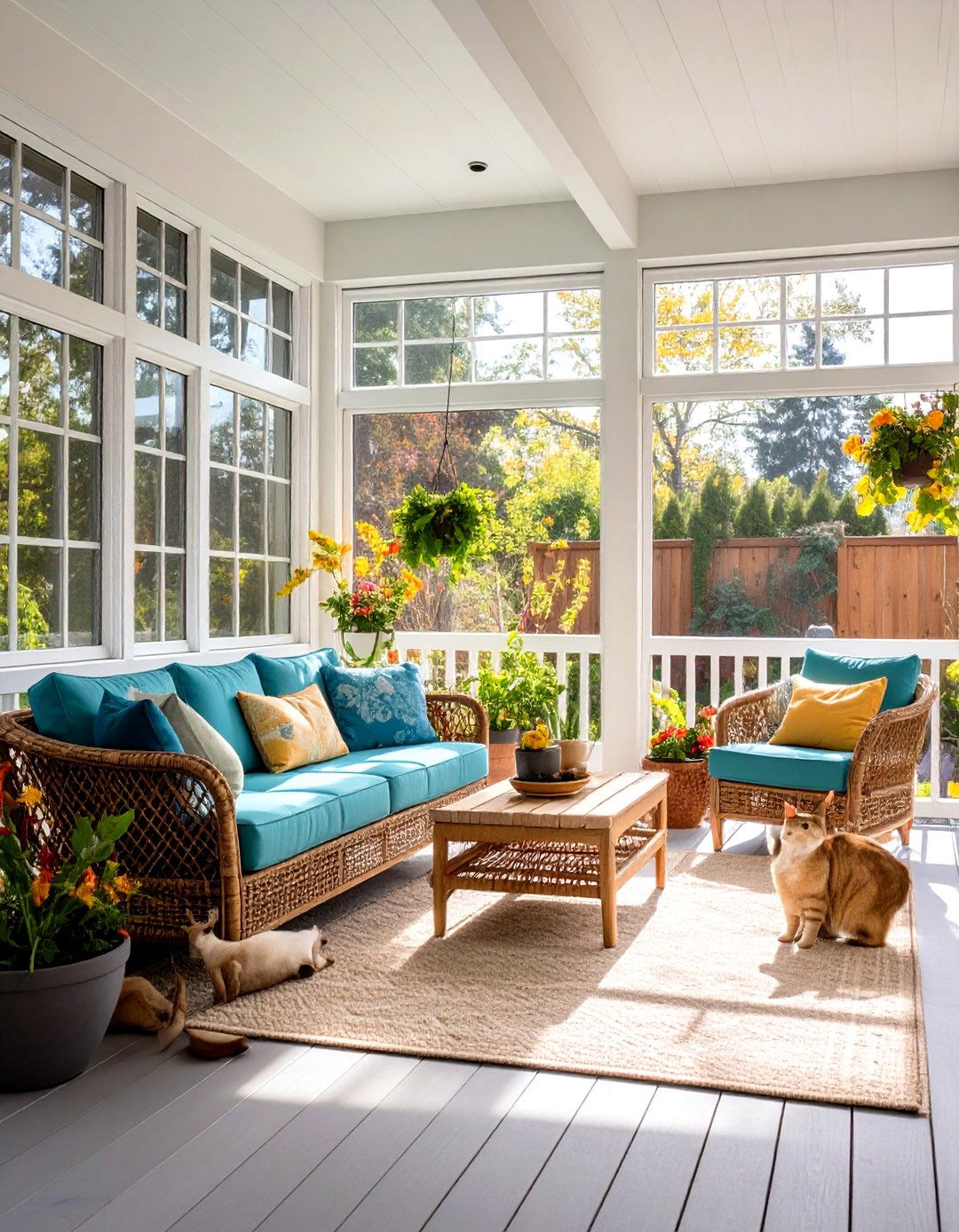
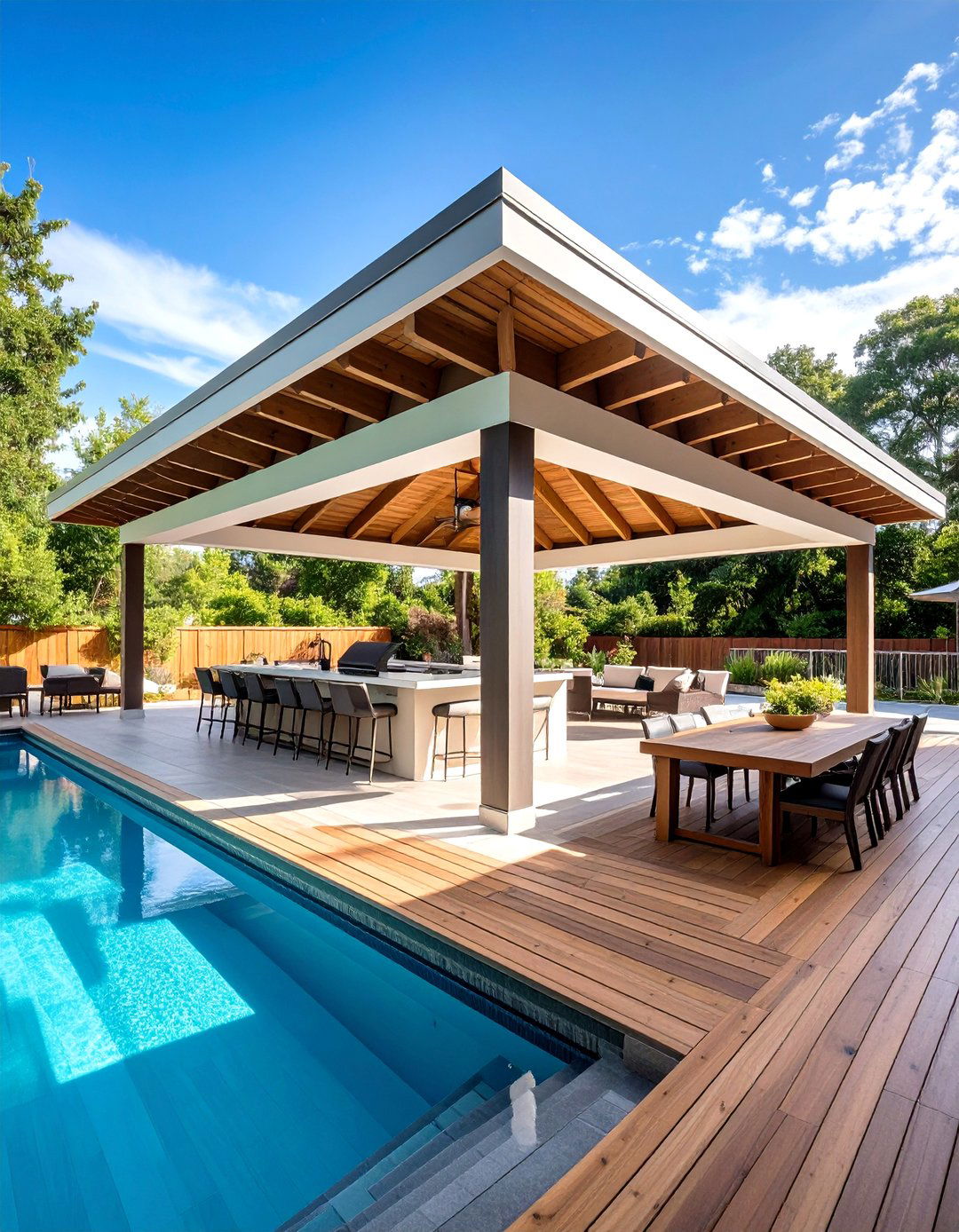
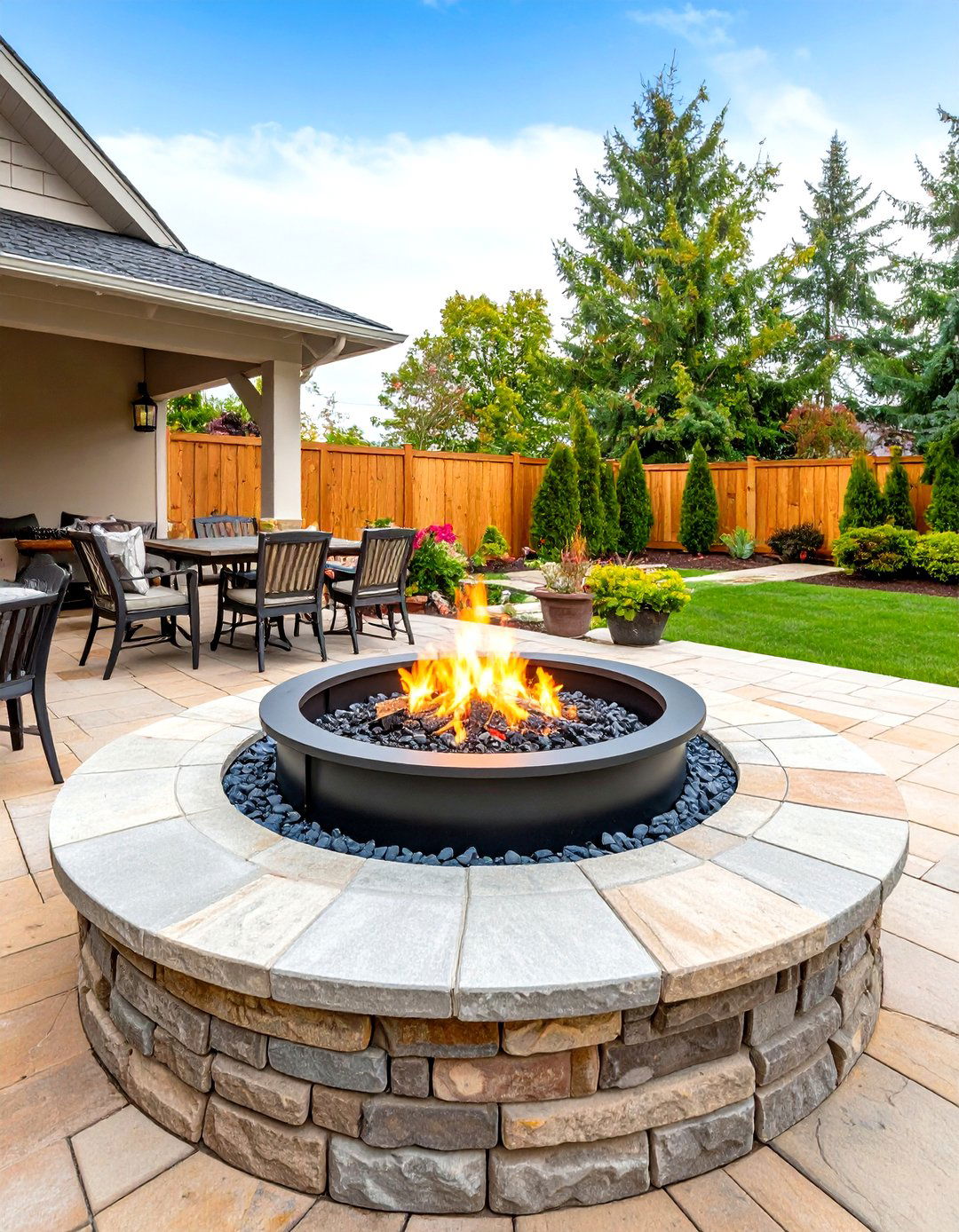
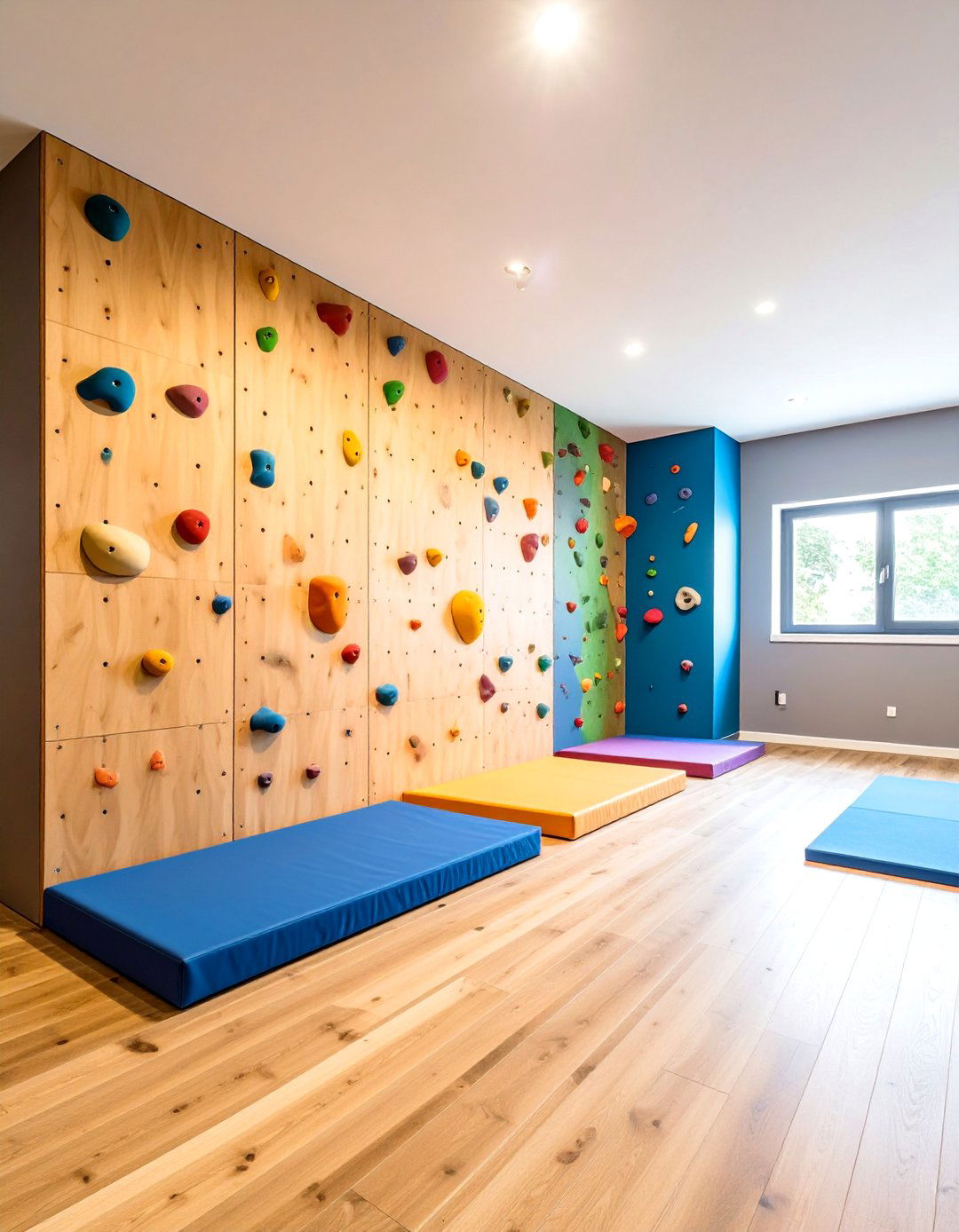
Leave a Reply